Marius was responsible for enacting a series of important reforms of the Roman Army, and as a general he defeated the invading Teutones, Ambrones and Cimbri.
In 91 BC Marcus Livius Drusus was elected Tribunis Plebis and revived the cause of the Gracchi brothers by proposing to extend Roman citizenship to all freemen of Italy. He was assassinated, and the Italian allies cities - the Socii - rebelled in what is known as the Social War.
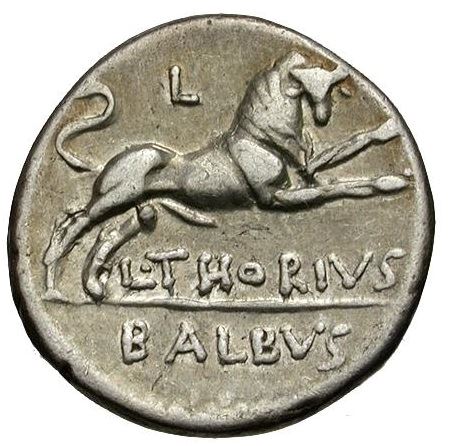
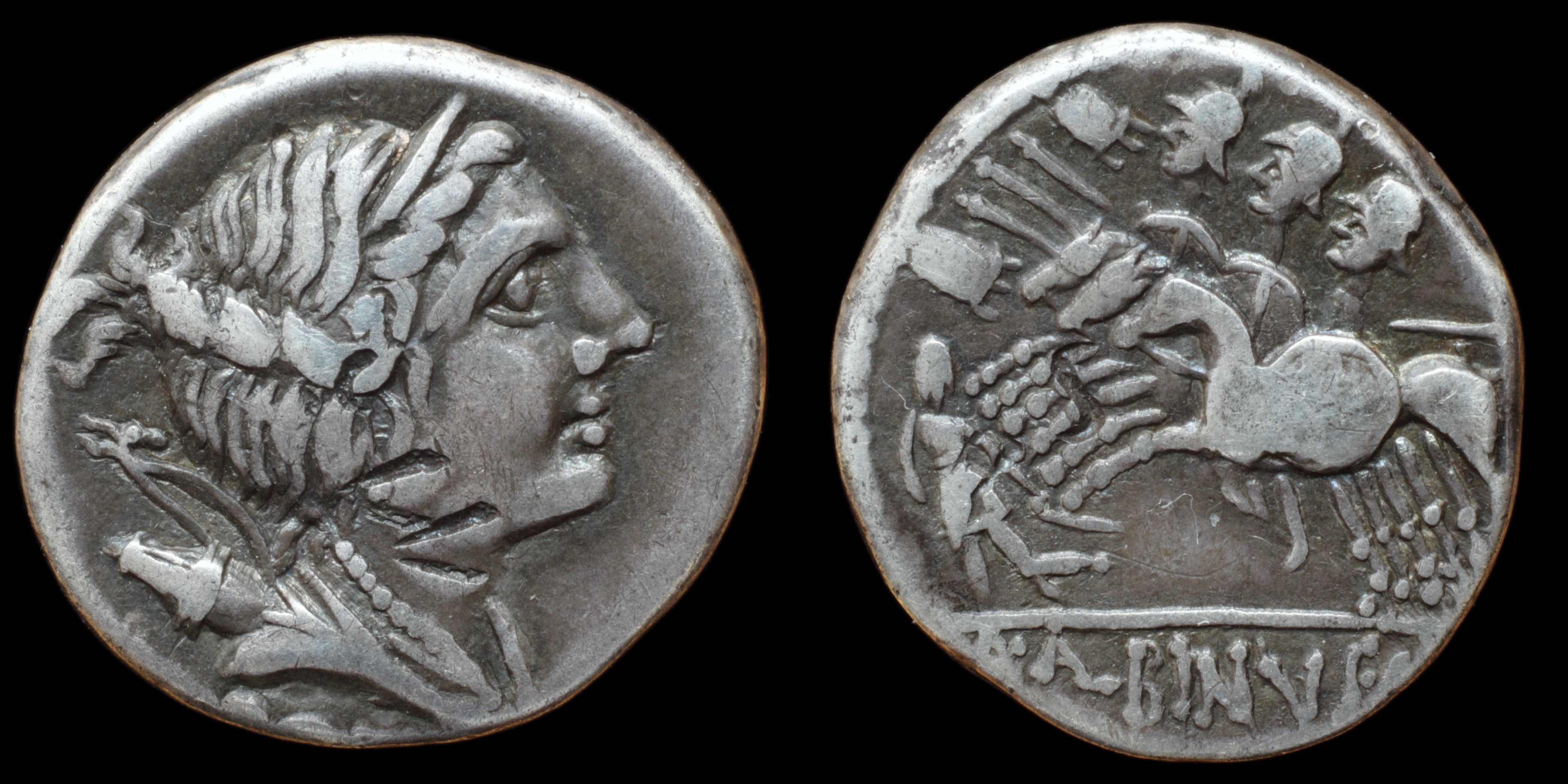
Reverse: 3 horsmen galloping left (A. Postumius Albus Regillensis); fallen enemy and two standards in front of them; A·(AL)BINVS·S·F
Die Orientation: -
Weight: 3.9 g
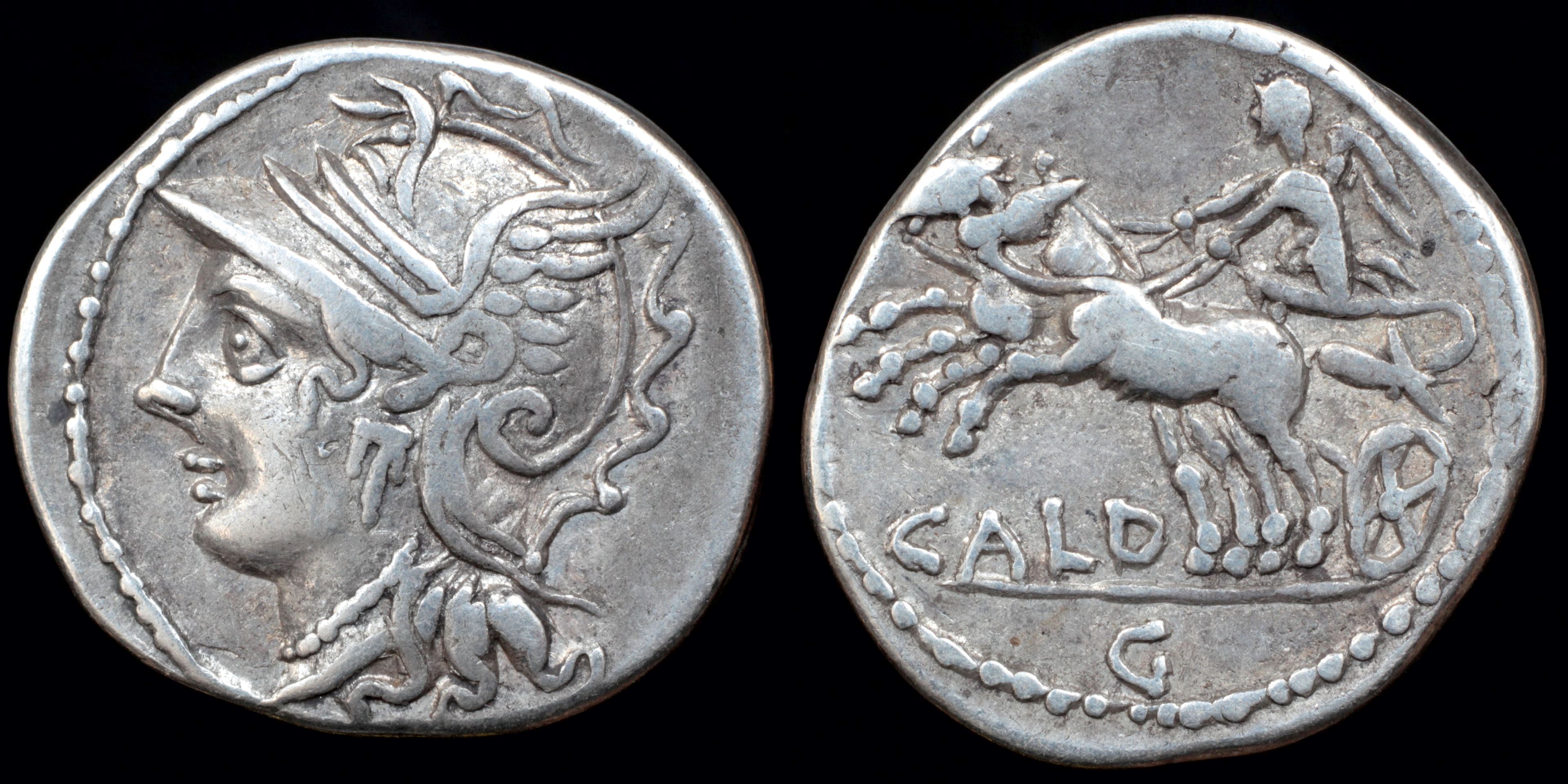
Reverse: Victory in biga left CALD G
Die Orientation: -
Weight: 3.9 g
Moneyer was consul in 94 BC. In 107 BC, he was elected tribune of the plebs and passed a lex tabellaria, which ordained that in the courts of justice the votes should be given by means of tables in cases of high treason. He was a praetor in 100 or 99 BC, and proconsul of Hispania Citerior the following year. This is represented by standard on the obverse along with emblem of the conquered town Clunia.
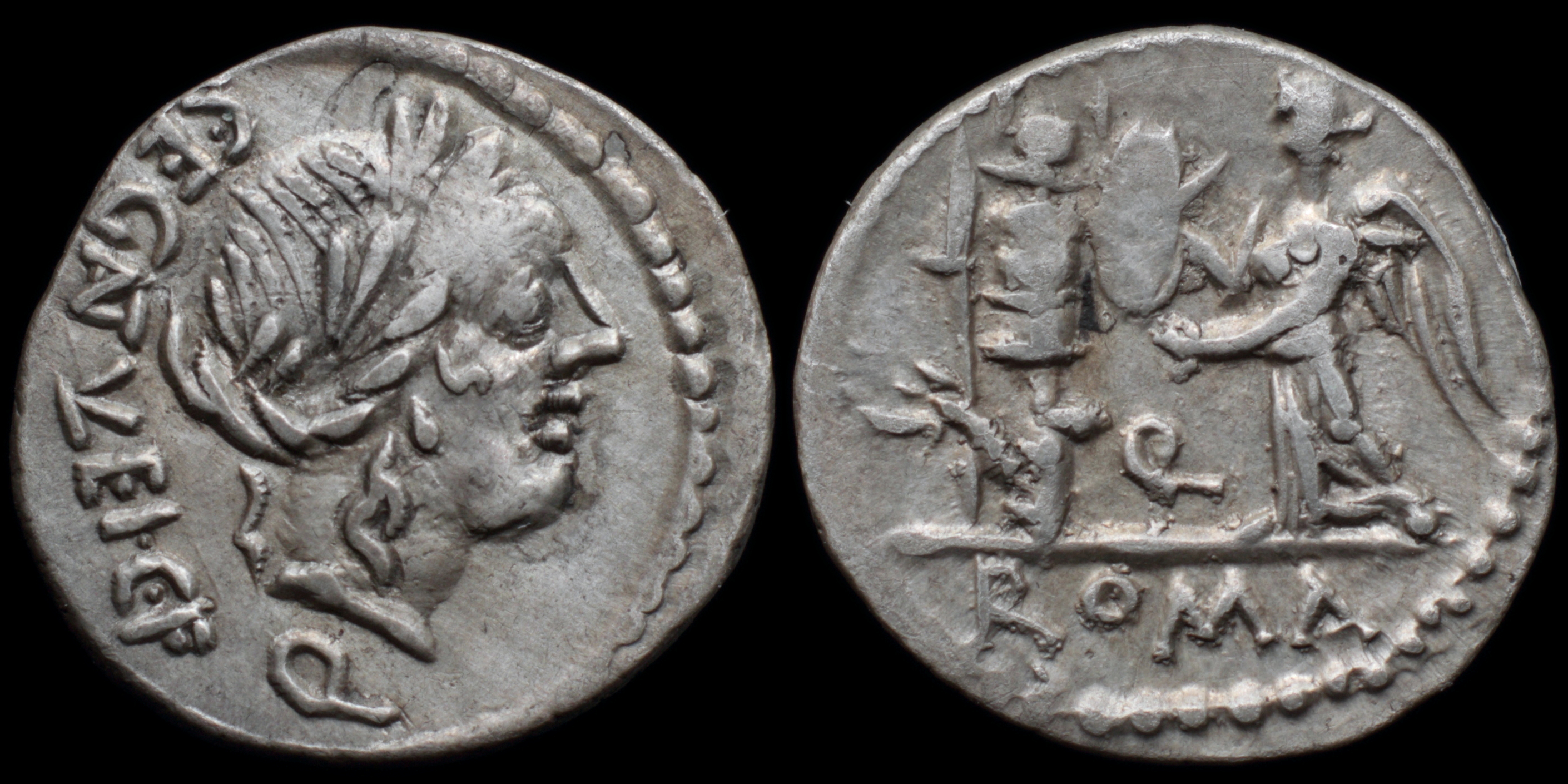
Reverse: Victory left insribing shield on trophy topped with a helmet ornamented with bull horns; carnyx at base of trophy; Q / ROMA
Die Orientation: -
Weight: 1.8 g
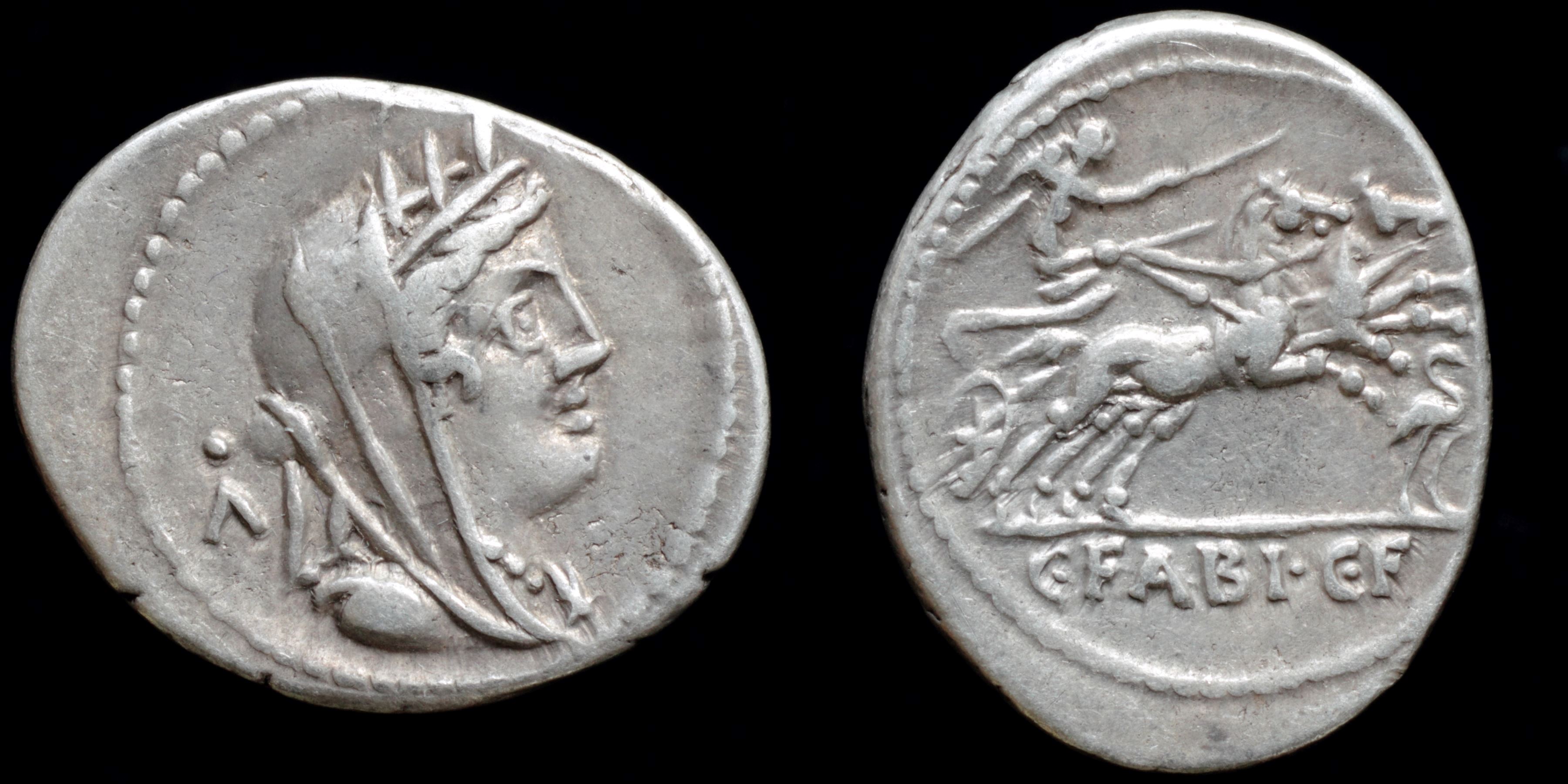
Reverse: Victory in biga right, holding goad and reins; heron right C·FABI·C·F
Die Orientation: -
Weight: 4 g
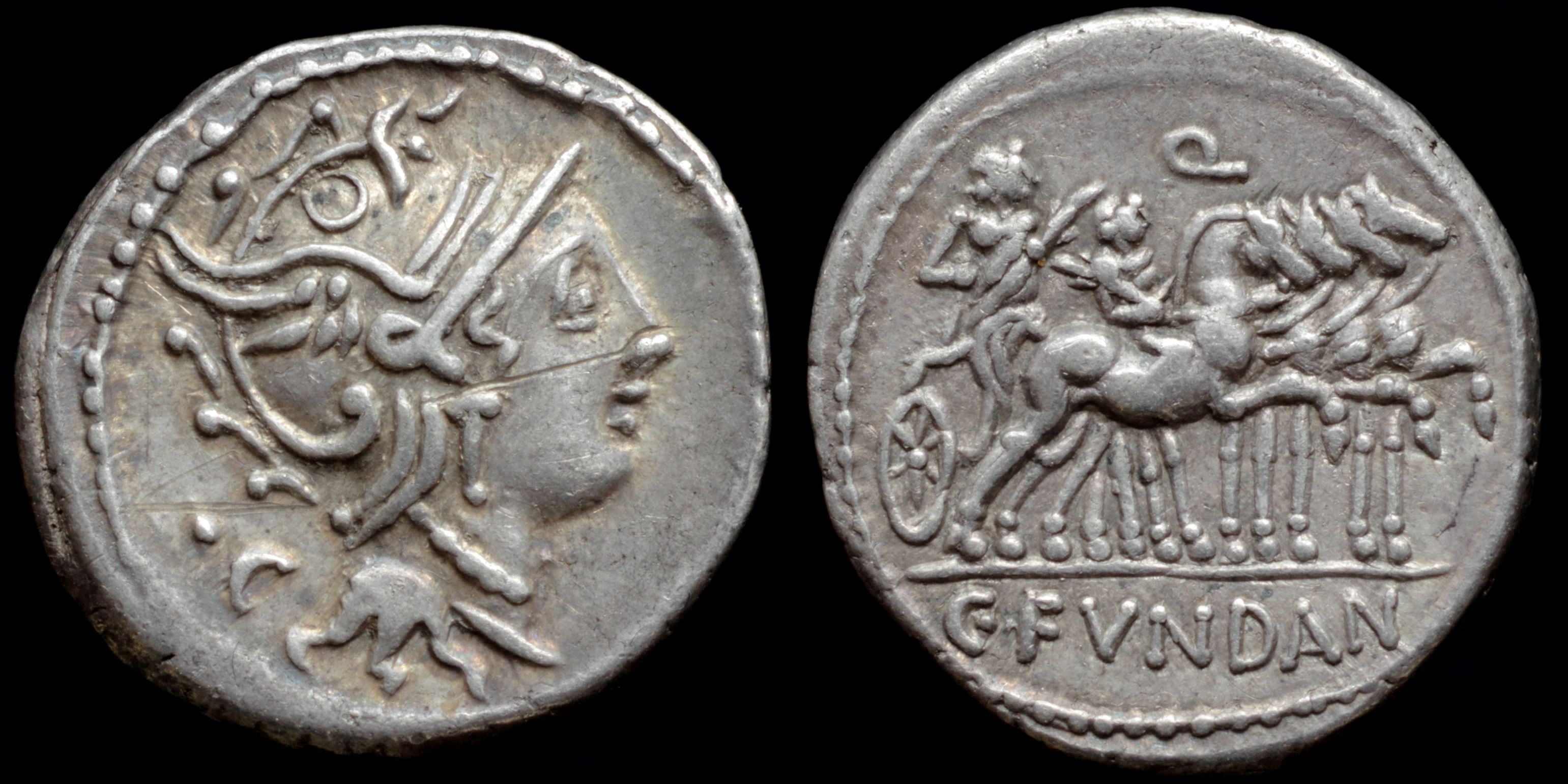
Reverse: Gaius Marius with his son as rider riding in triumphal quadriga right. Gaius Marius holds staff and laurel branch, rider holds laurel branch and reins. Q C·FVNDAN
Die Orientation: -
Weight: 4 g
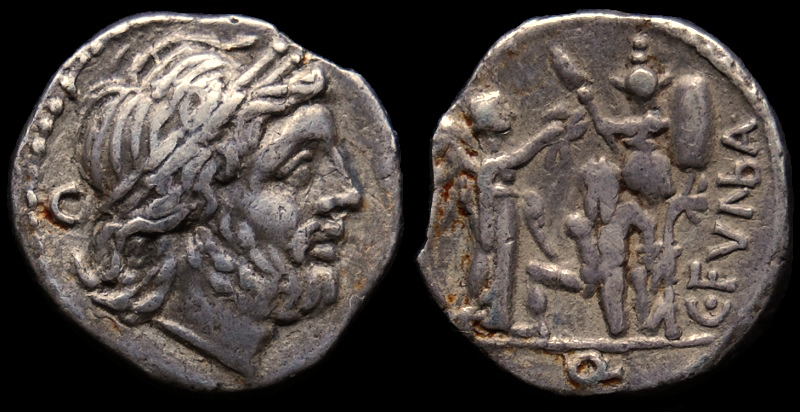
Reverse: Victory standing right, crowning trophy, beside which stands carnyx; before which, Gallic captive kneeling left; Q (mark of value) in exergue.
Die Orientation: -
Weight: 1.76 g
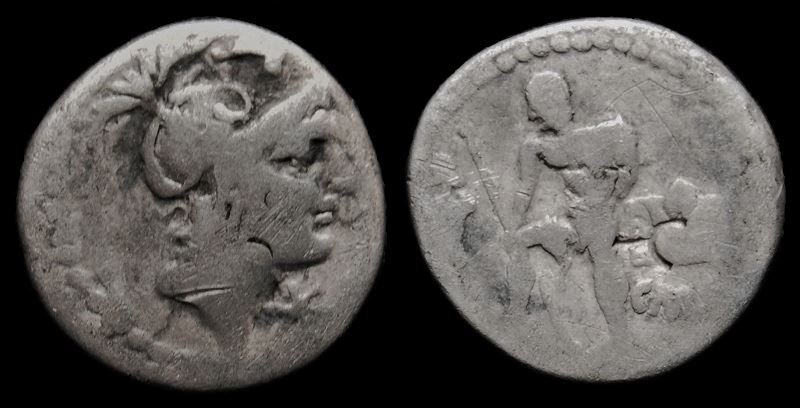
Reverse: Heroic figure standing left, foot on cuirass, holding spear and leaning on tabella divided into two compartments, CMA below, trophy in left field.
Die Orientation: 7 H
Weight: 3.6 g
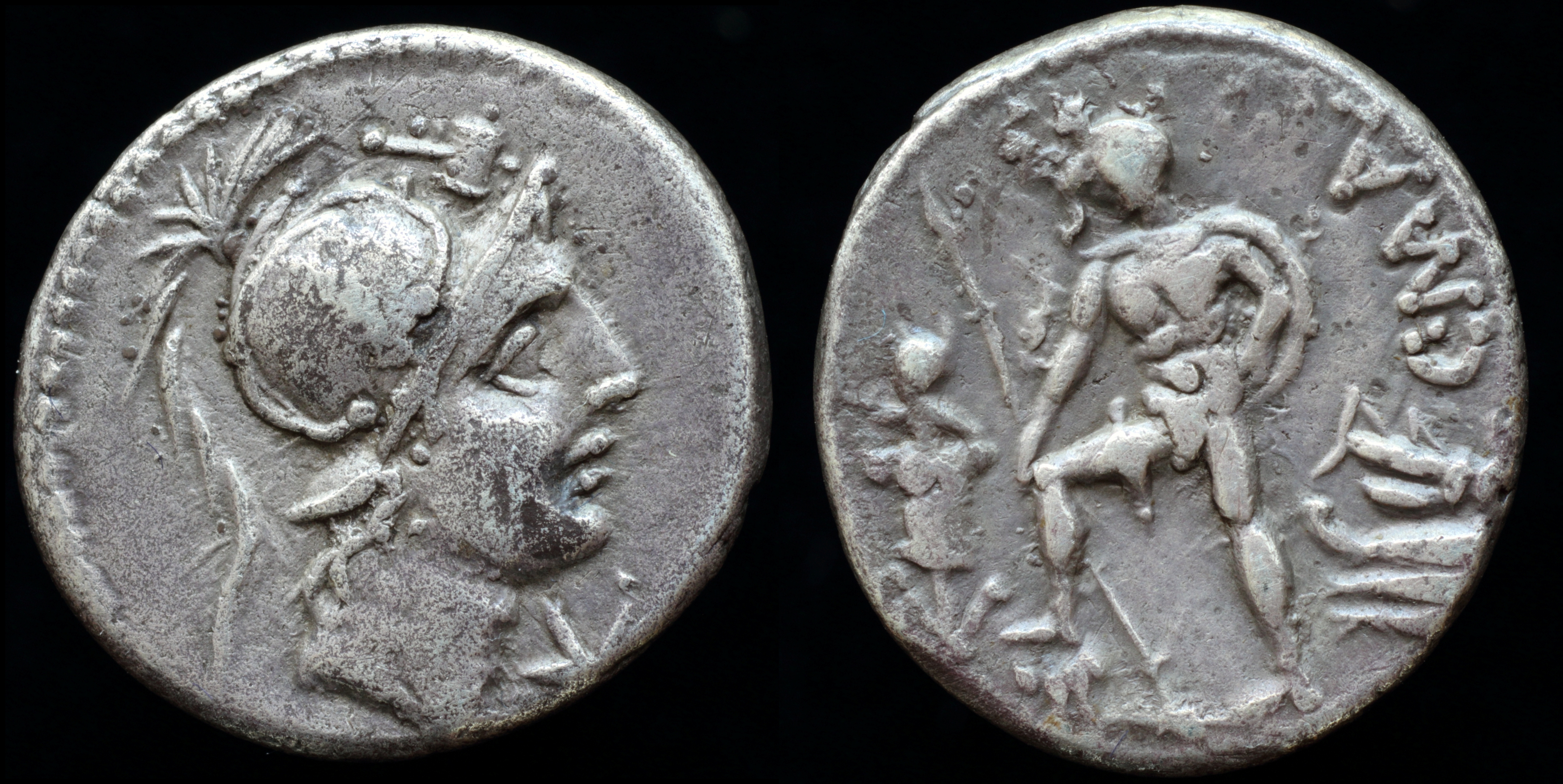
Reverse: warrior standing half left, foot on cuirass, holding spear; trophy left, grasshopper on prow right; C·M(AL)
Die Orientation: -
Weight: 3.8 g
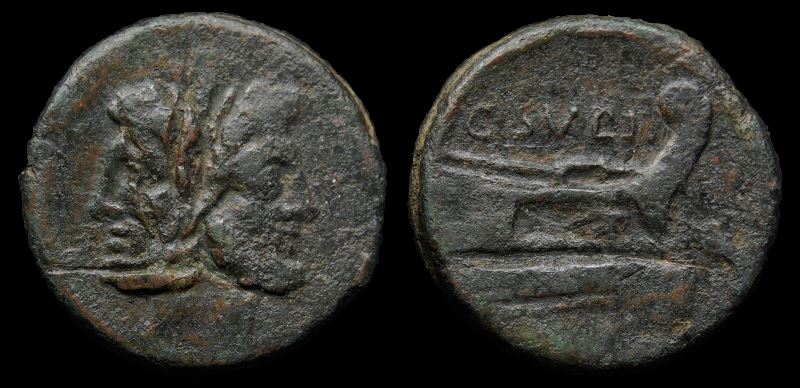
Reverse: Prow right; C•SVLPI above; palm-branch in right field; ROMA below.
Die Orientation: 0 H
Weight: 32.68 g
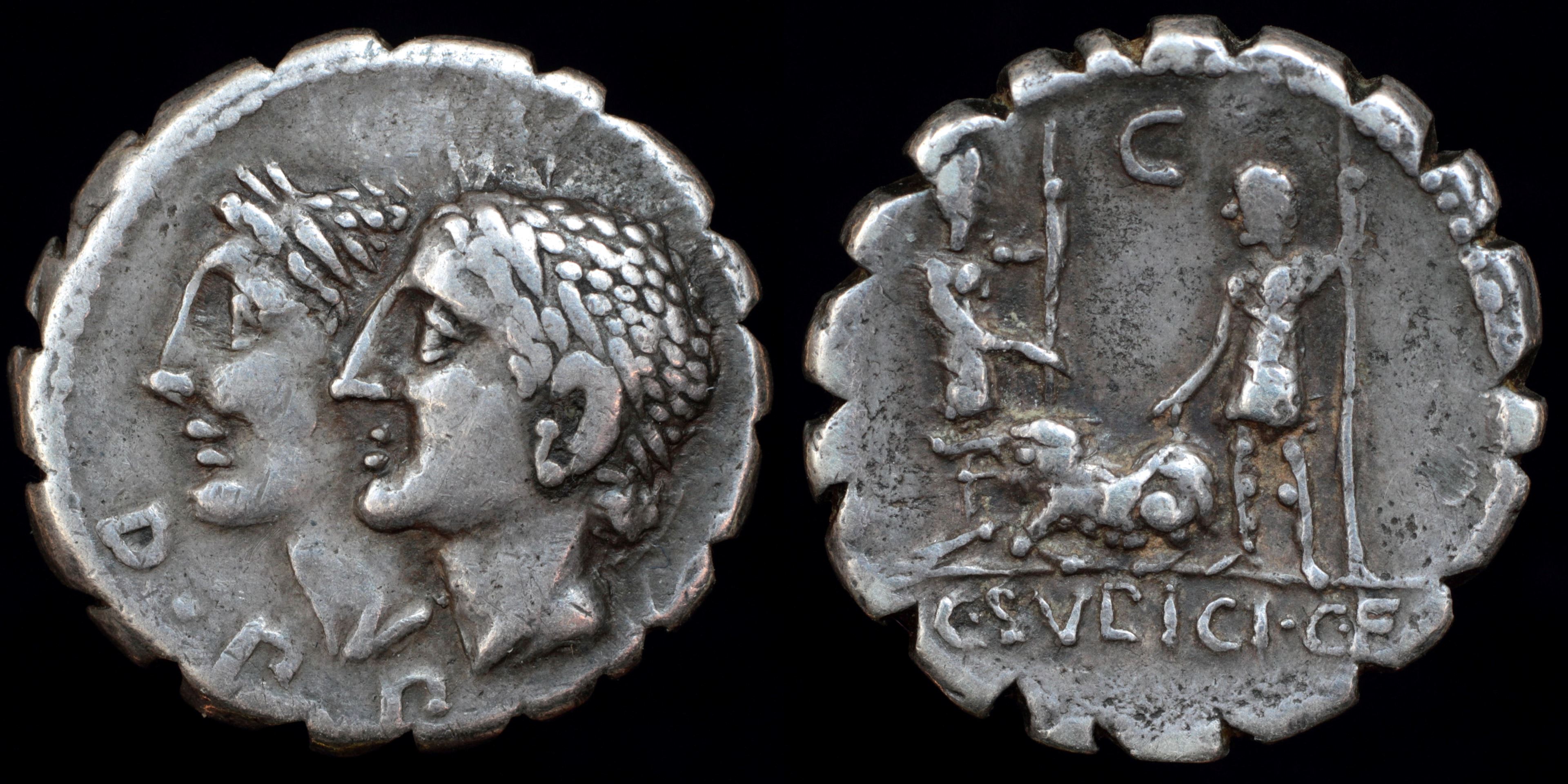
Reverse: Two soldiers (or Dii Penas Publici) standing facing each other, holding spears and pointing at sow which lies between them C C·SV(LP)ICI·C·F
Die Orientation: -
Weight: 3.96 g
The Sulpicii came from Lavinium and both sides of coin are related to it. Di Penates Publici were taken from Troy together with Palladium by Aeneas. When Aeneas fled from Troy Helenus, a son of Priamos, has predicted Aeneas, that he would built a new city where a white sow would cast 30 piglets. Aeneas prepared to sacrifice a pregnant white sow he has brought in his ship for this purpose, but the sow escaped and fled 24 stadiums in the inland, layed down under an oak-tree (or ilex-tree) and casted 30 white piglets. Because of that Aeneas knew that this prophecy too became true and he should built a city here. He sacrificed the 30 piglets and erected a shrine at this place. The new city he called Lavinium referring to Lavinia, daughter of king Latinus. The 30 piglets represented 30 years only after which his successors became the real owners of the new land. At the same time story of white sow predicts foundation of another town: River god Tiber speak to Aeneas in a dream: ".... A sow beneath an oak shall lie along, All white herself, and white her thirty young. When thirty rolling years have run their race, Thy son Ascanius, on this empty space, Shall build a royal town, of lasting fame, Which from this omen shall receive the name. ..." Alba Longa was founded just 30 years after Lavinium and so the prophecy was fulfilled here too. The name Alba Longa is said to be derived from the white sow (meaning the long white). So Lavinium was the mothertown of Alba Longa and finely of Rome itself. On the Forum of Lavinium stood a bronze statue of the sow, its body was conserved by the priests in pickle. (Jochen's coins of mythological interests)
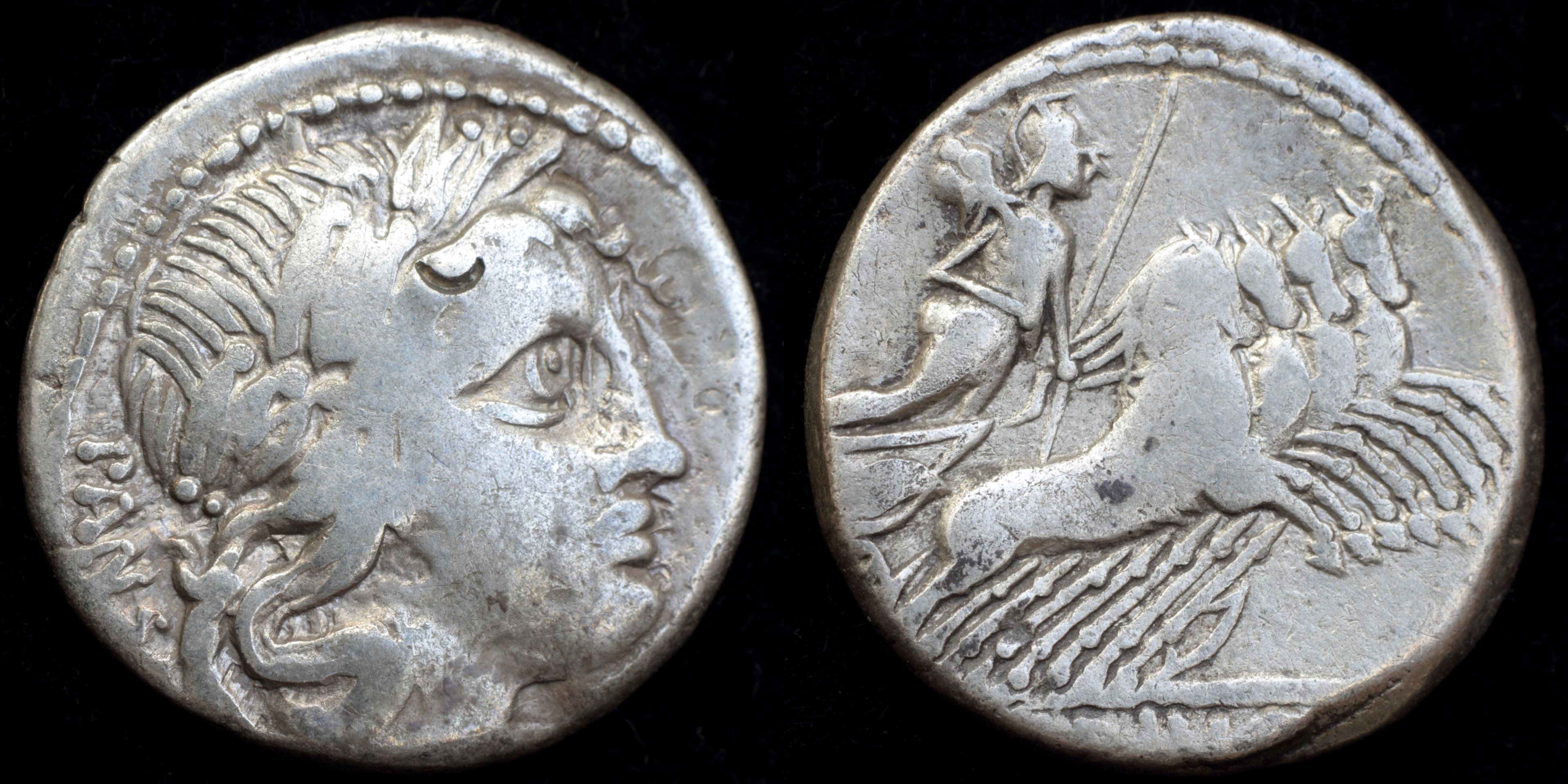
Reverse: Minerva in quadriga right holding trophy and reins, spear C·VIBIVS·C·F
Die Orientation: -
Weight: 3.96 g
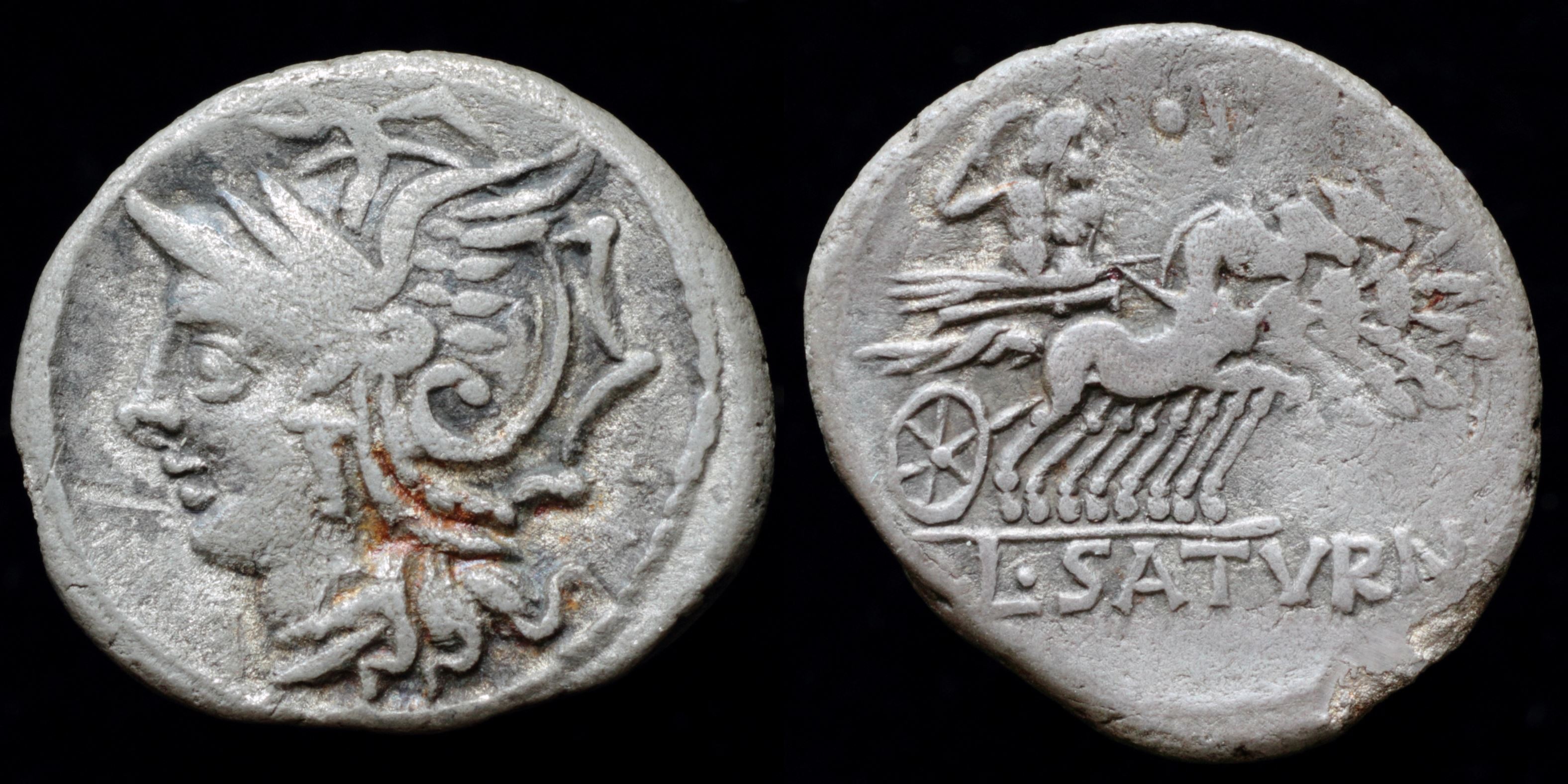
Reverse: Saturn in quadriga right holding harpa and reins, P with dot above* and to the left L·SATVRN
Die Orientation: -
Weight: 3.66 g
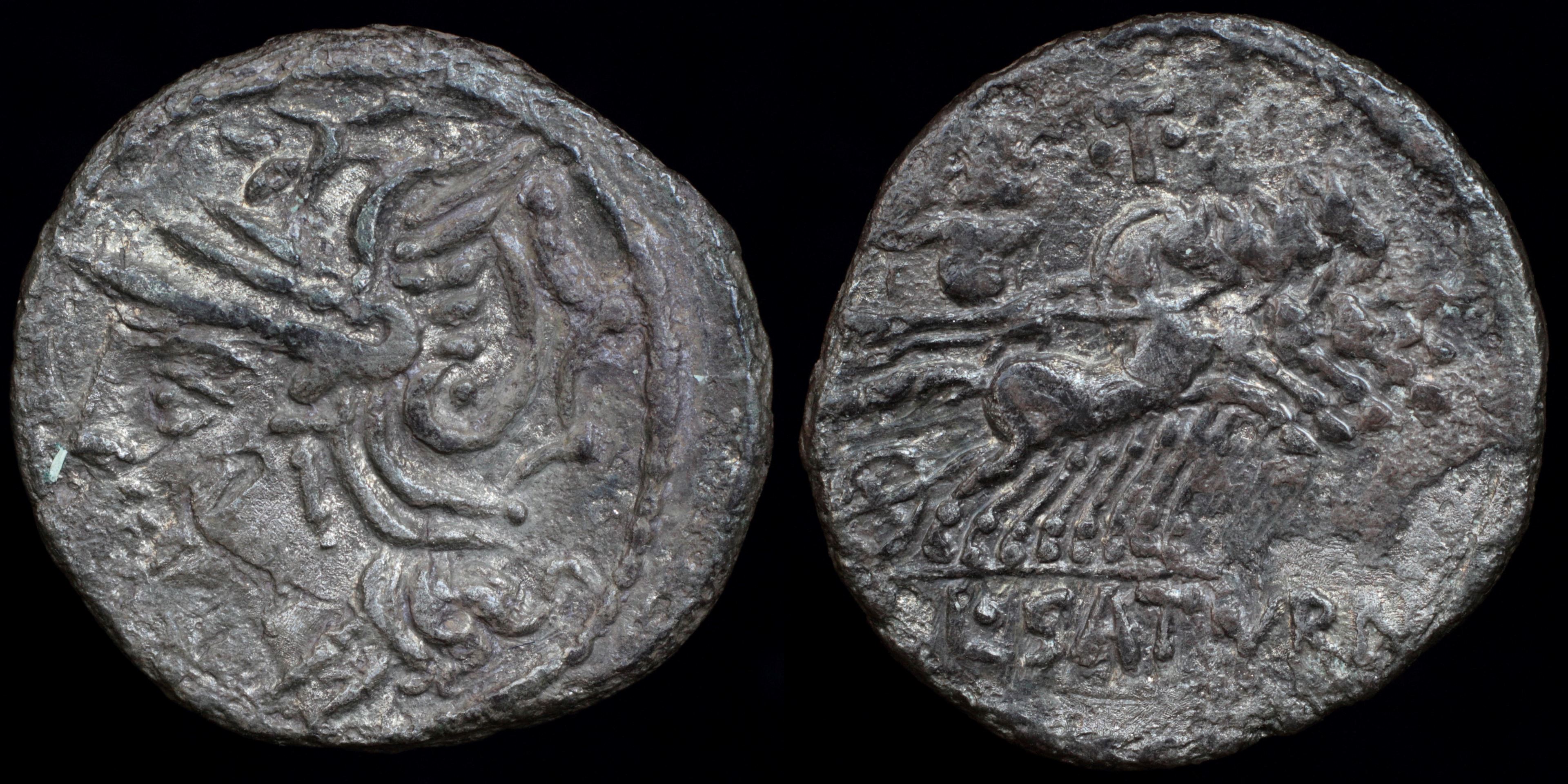
Reverse: Saturn in quadriga right holding harpa and reins ·T· L·SATVRN
Die Orientation: -
Weight: 3.5 g
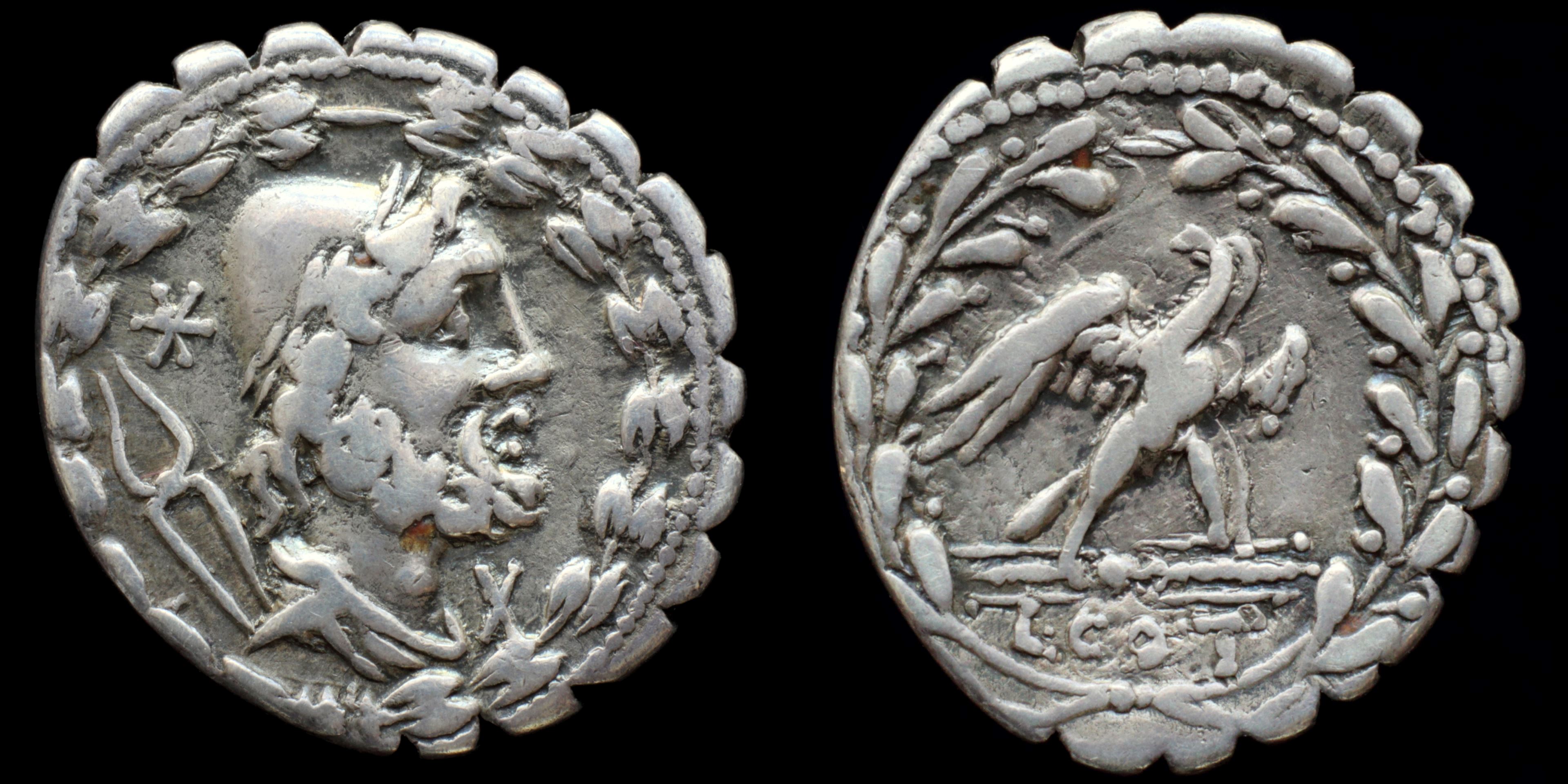
Reverse: eagle on thunderbolt right, head left, all within laurel wreath; L·COT
Die Orientation: -
Weight: 3.4 g
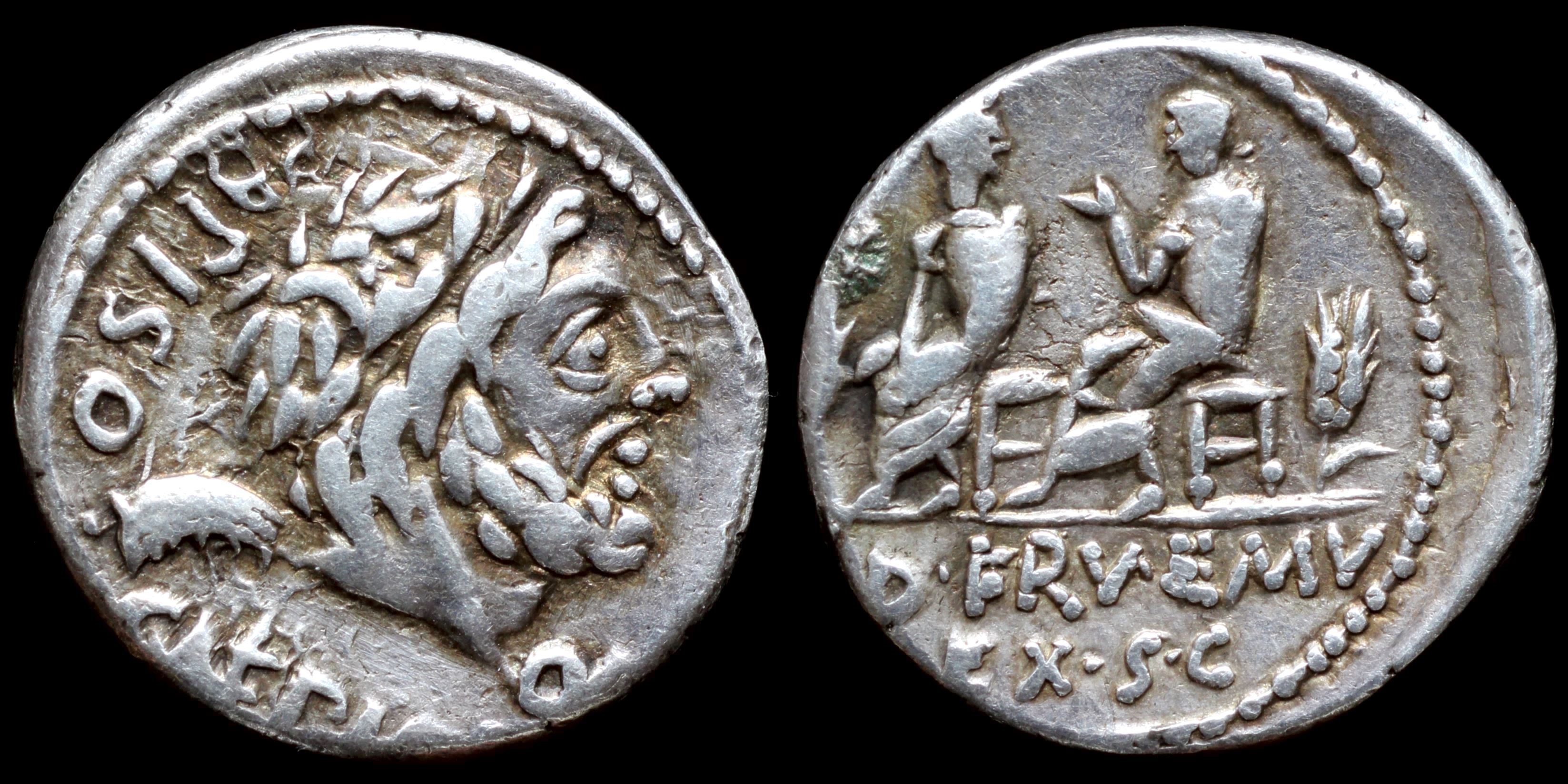
Reverse: two questors seated left between two stalk of grain; AD·FRV·EMV / EX·S·C
Die Orientation: -
Weight: 4.1 g
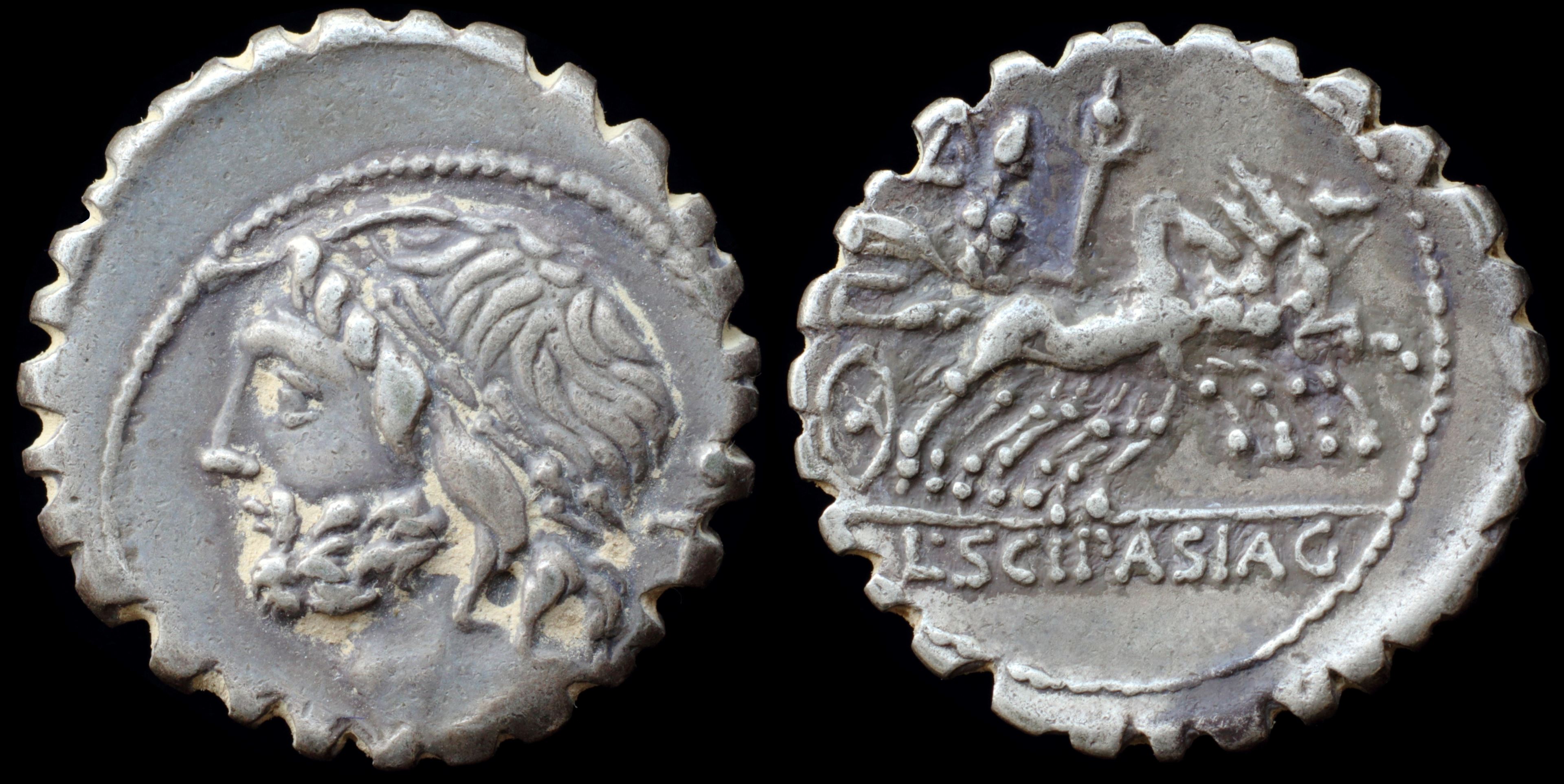
Reverse: Jupiter in quadriga right, hurling thunderbolt, holding reins and scepter L·SCIP·ASIAG
Die Orientation: -
Weight: 3.4 g
Moneyer was the great-grandson of Lucius Cornelius Scipio Asiaticus, consul 190 BC who together with Eumenes II of Pergamum defeated Antiochus III the Great. He belonged to the Marian party in Sulla's first civil war and Sulla's second civil war. He was appointed consul in 83 BC with Gaius Norbanus. In this year Lucius Cornelius Sulla returned to the Italian Peninsula, and advanced against the consuls. He defeated Norbanus in Italy, but seduced the troops of Scipio to desert their general. He was taken prisoner in his camp along with his son Lucius, but was dismissed by Sulla uninjured. He was, however, included in the proscription in the following year, 82 BC, whereupon he fled to Massilia, and passed there the remainder of his life. (wikipedia)
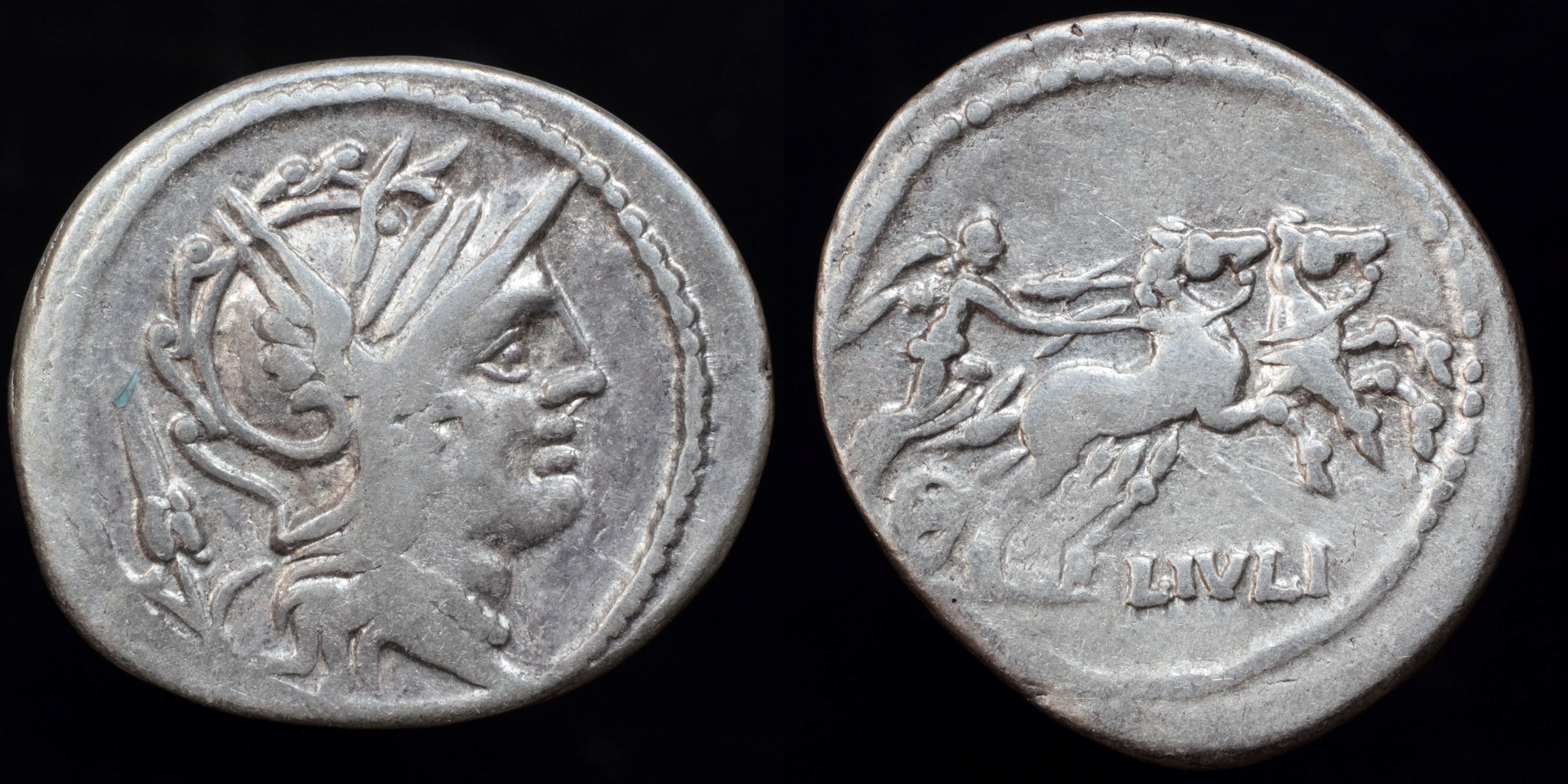
Reverse: Victory in biga right L·IVLI
Die Orientation: -
Weight: 3.8 g
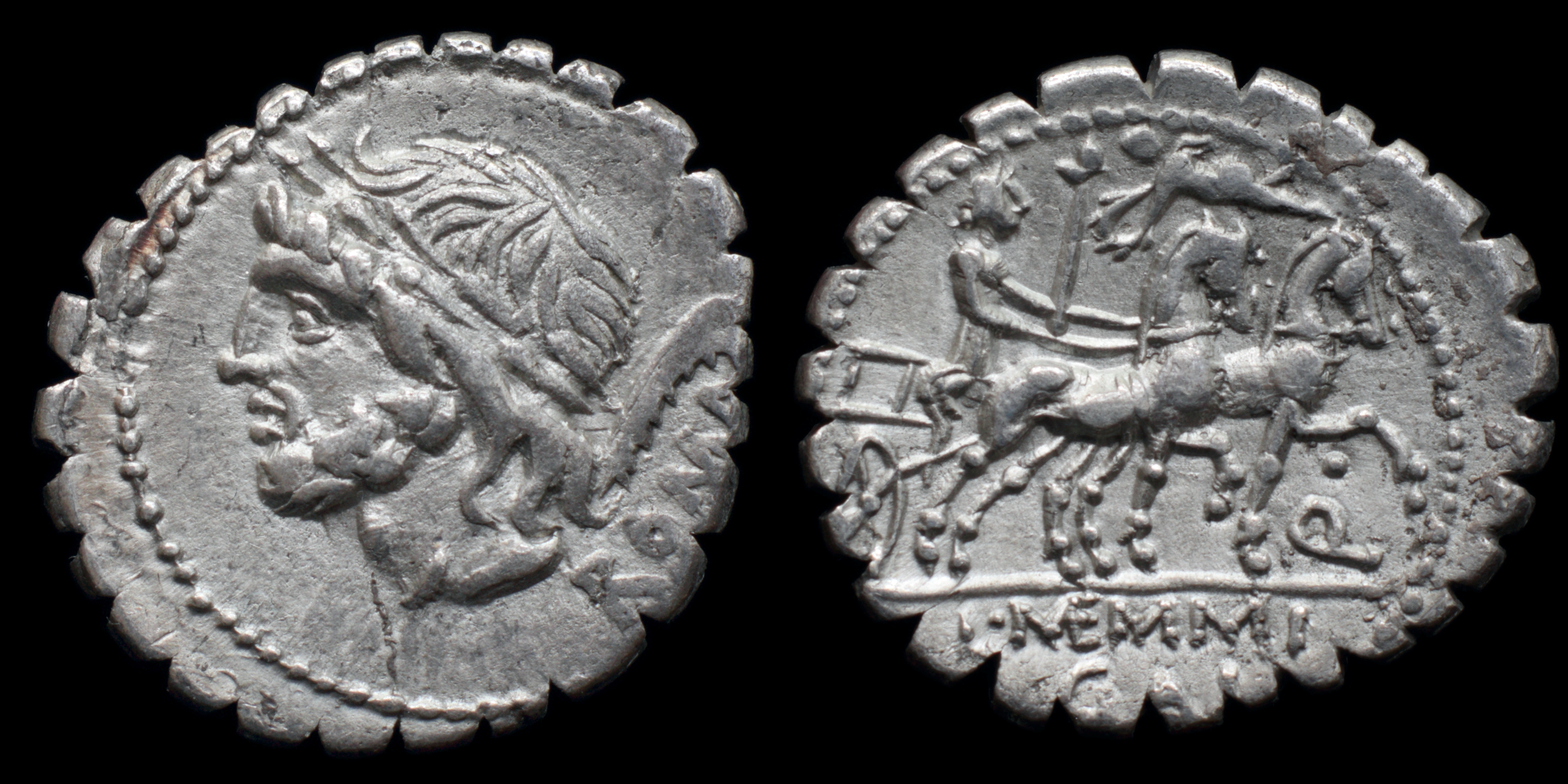
Reverse: Venus in slow biga right holding scepter and reins; above Cupid flying left, holding wreath; ·/Q // L·(ME)MMI / GAL
Die Orientation: -
Weight: 3.9 g
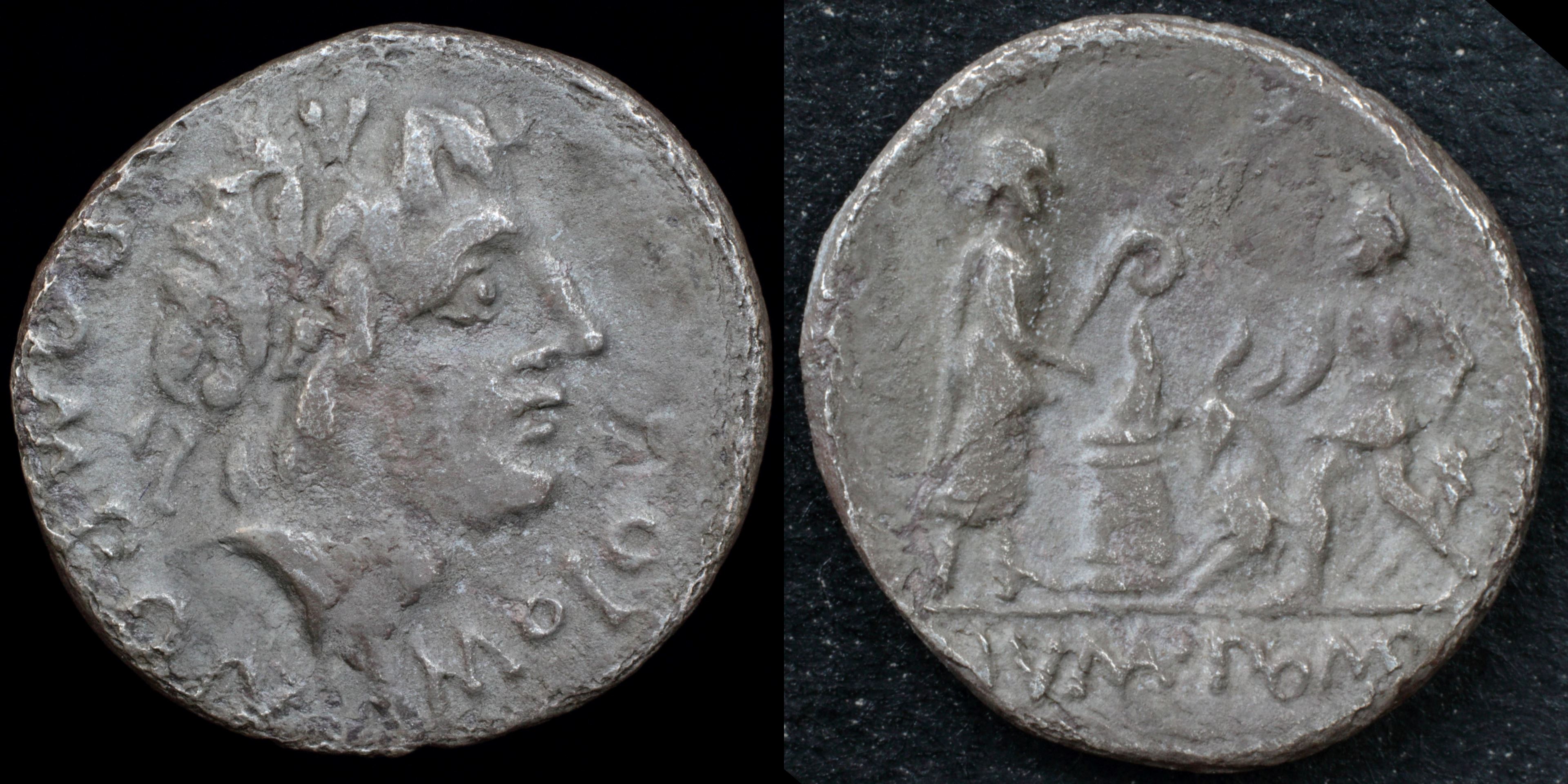
Reverse: Numa Pompilius holding litus, standing right before altar preparing to sacrifice a goat which is being held by a youth NV(MA)·PO(MP)IL
Die Orientation: -
Weight: 3.46 g
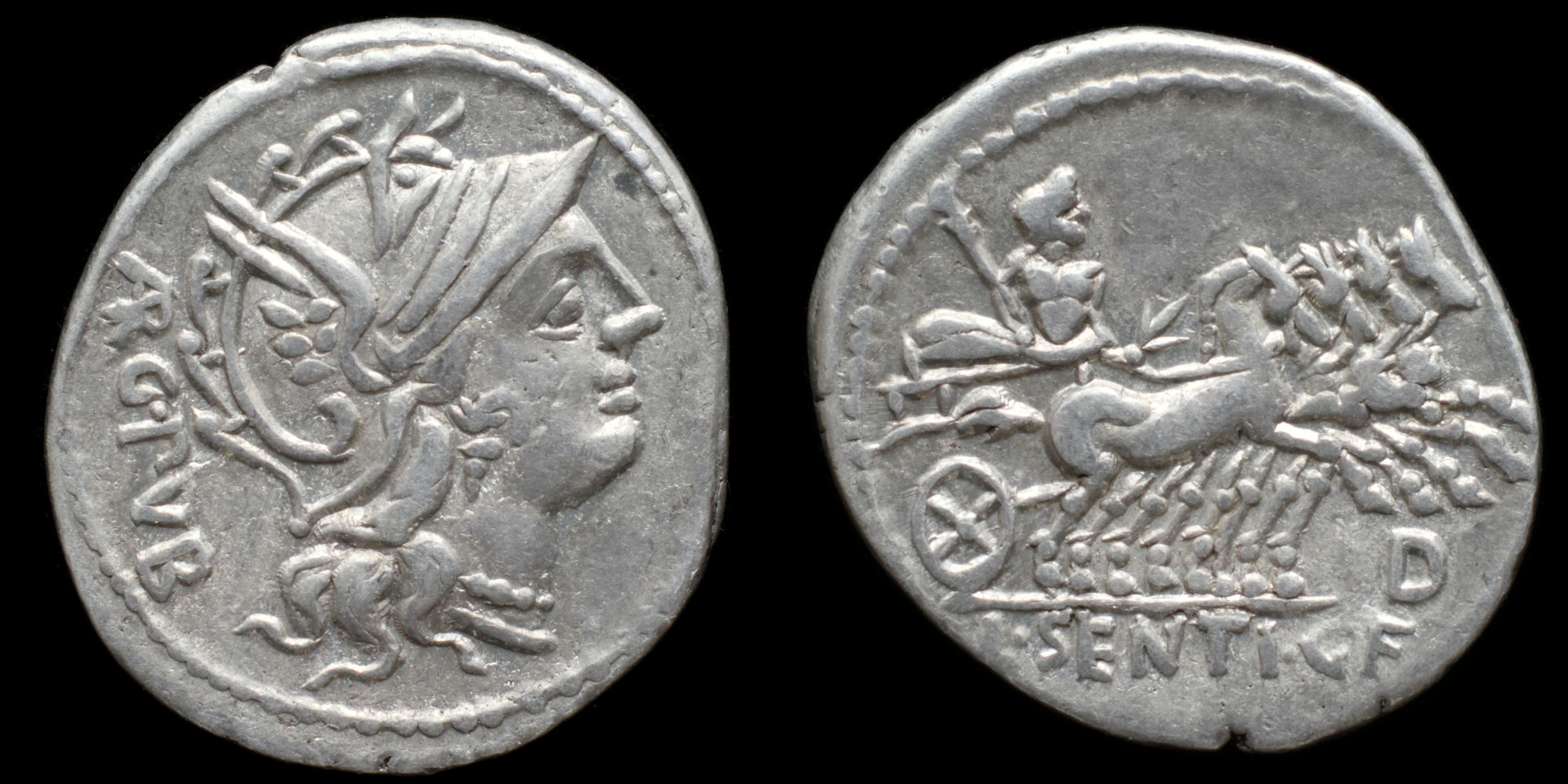
Reverse: Jupiter in quadriga right, holding scepter, thunderbolt and reins; D / L·SENTI·C·F
Die Orientation: -
Weight: 4 g
(10).JPG)
Reverse: Bull charging right, X above, L•THORIVS below, BALBVS in exergue
Die Orientation: 7 H
Weight: 3.8 g
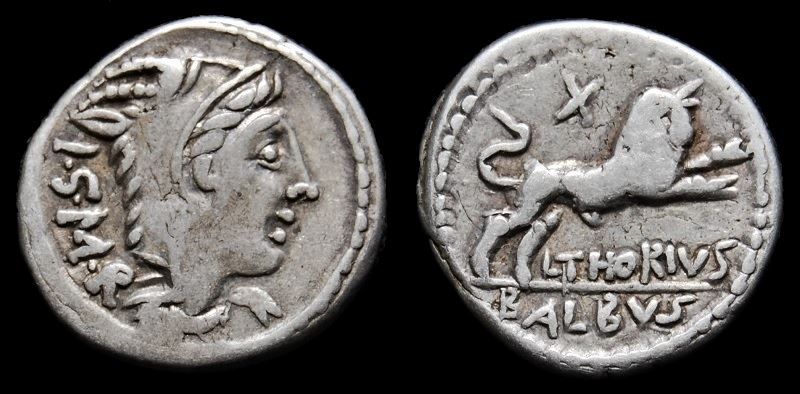
Reverse: Bull charging to right, L THORIVS below, BALBVS in exergue, X above.
Die Orientation: 6 H
Weight: 3.9 g
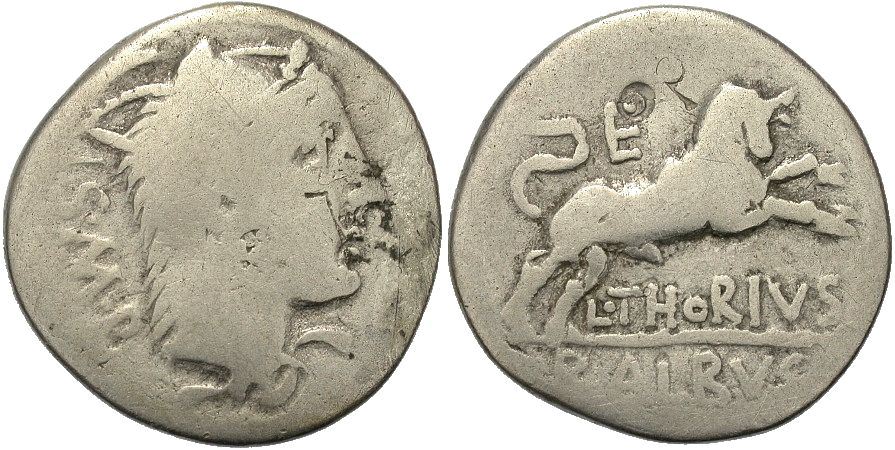
Reverse: Bull charging right, E (control letter) above, L.THORIVS below, BALBVS in exergue
Die Orientation: 6 H
Weight: 3.5 g
The cognomen 'Balbus' literally means 'stammerer', and was used to denote a particular branch within a Gens.
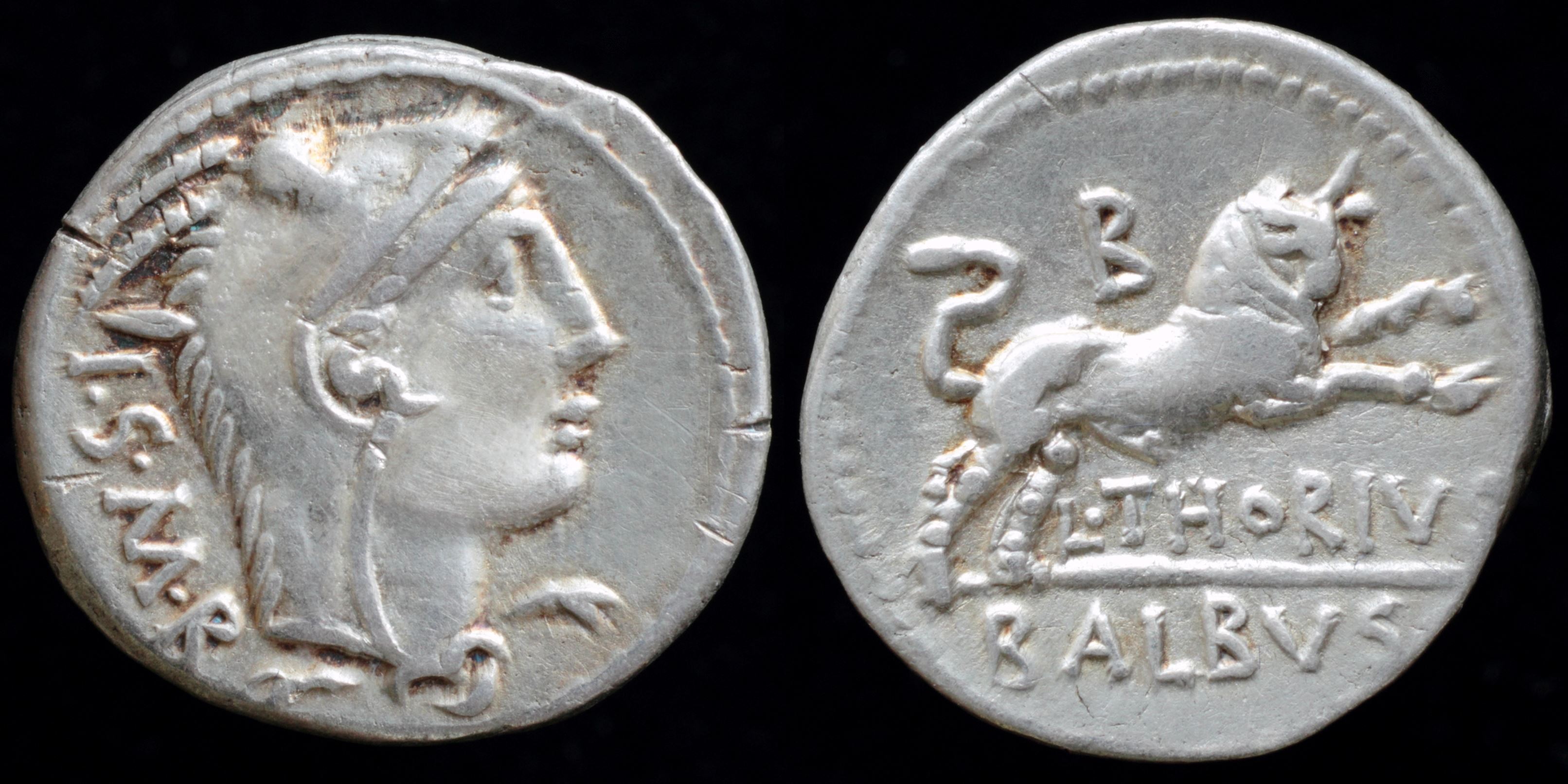
Reverse: bull charging right B L·THORIVS BALBVS
Die Orientation: -
Weight: 3.9 g

Reverse: Bull charging right; V above
Die Orientation: 7 H
Weight: 3.84 g
Excellent style, with attractive toning. Came with a 1930's hand-written envelope.
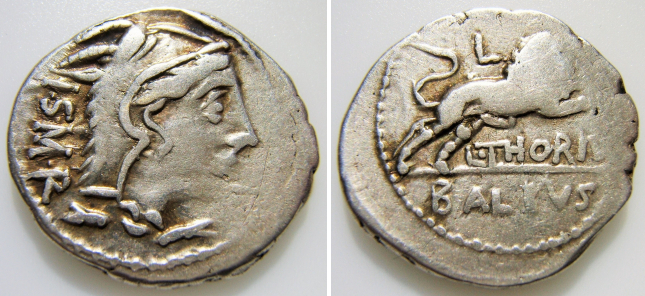
Reverse: L•THORIVS BALBVS / L - Bull charging right; L above.
Die Orientation: 6 H
Weight: 4.02 g
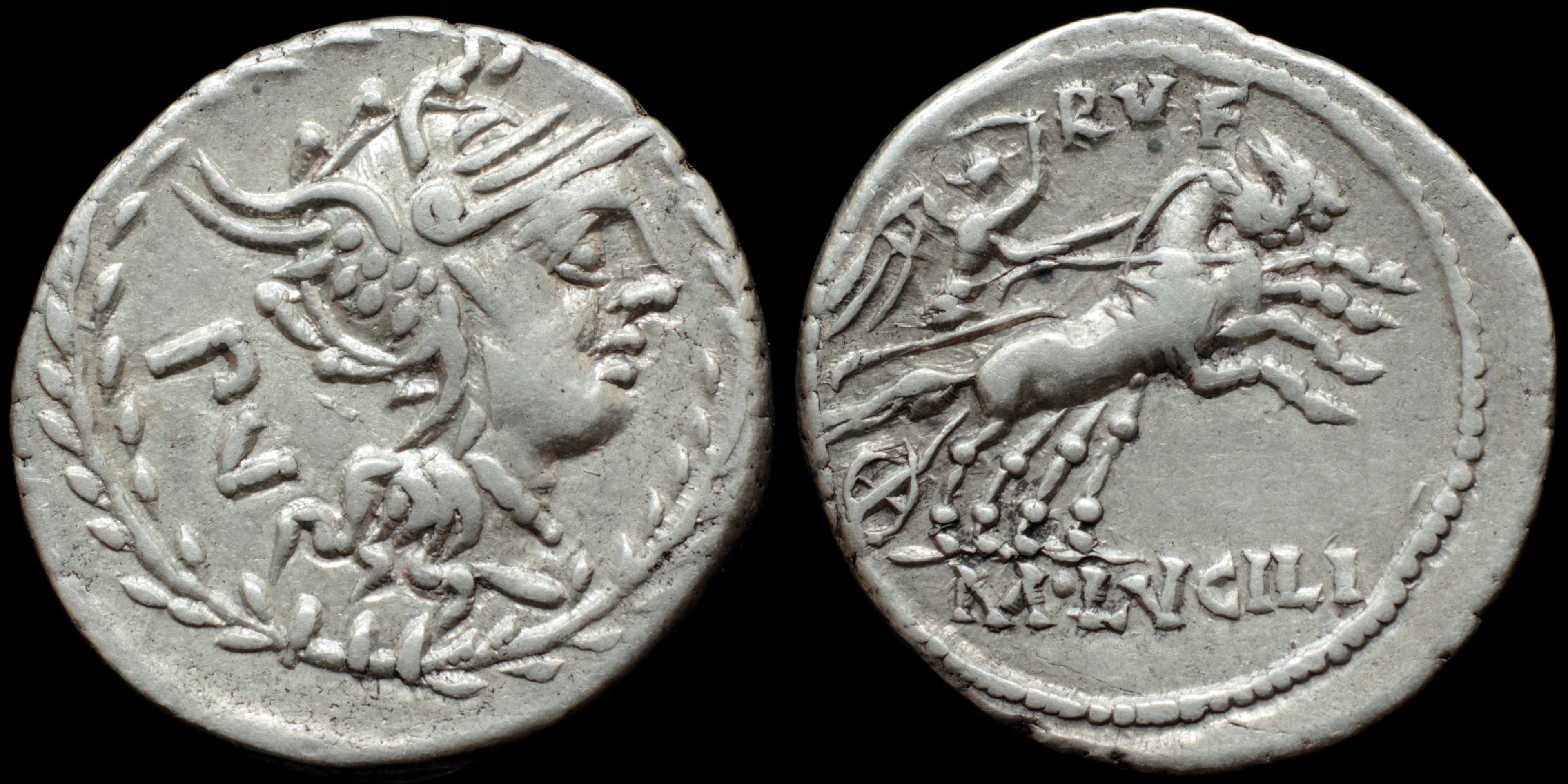
Reverse: Victory in biga left, holding whip and reins RVF M·LVCILI
Die Orientation: -
Weight: 3.9 g
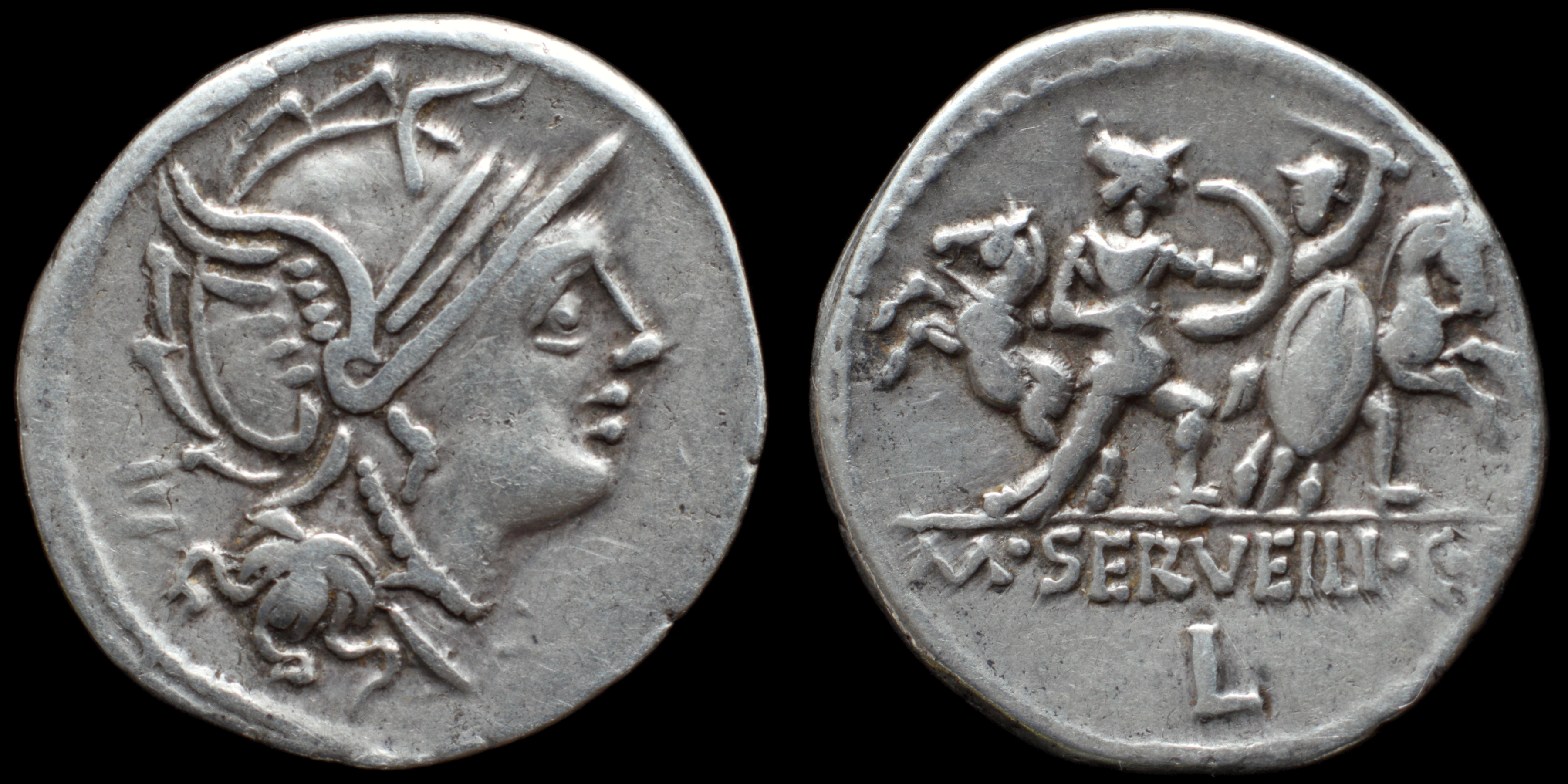
Reverse: Two dismounted horsmen fighting duel with their horses behind, each holding sword and shield; M·SERVEILI·C·F / L
Die Orientation: -
Weight: 3.9 g
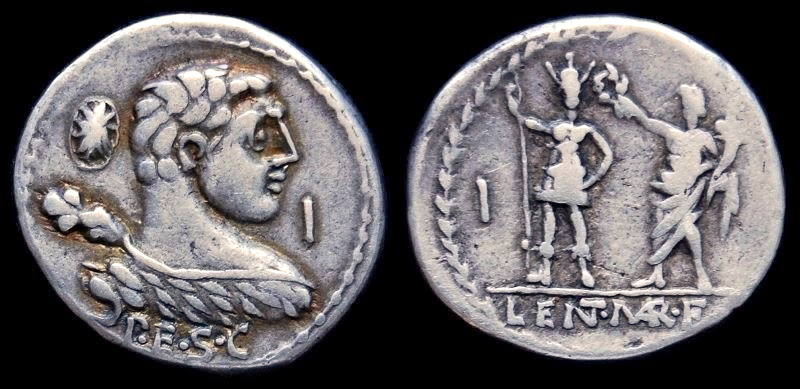
Reverse: Roma facing, holding spear, being crowned by Genius of the Roman People right; I (control mark) in left field, LENT•MAR•F in exergue; all within laurel-wreath.
Die Orientation: 11 H
Weight: 3.89 g
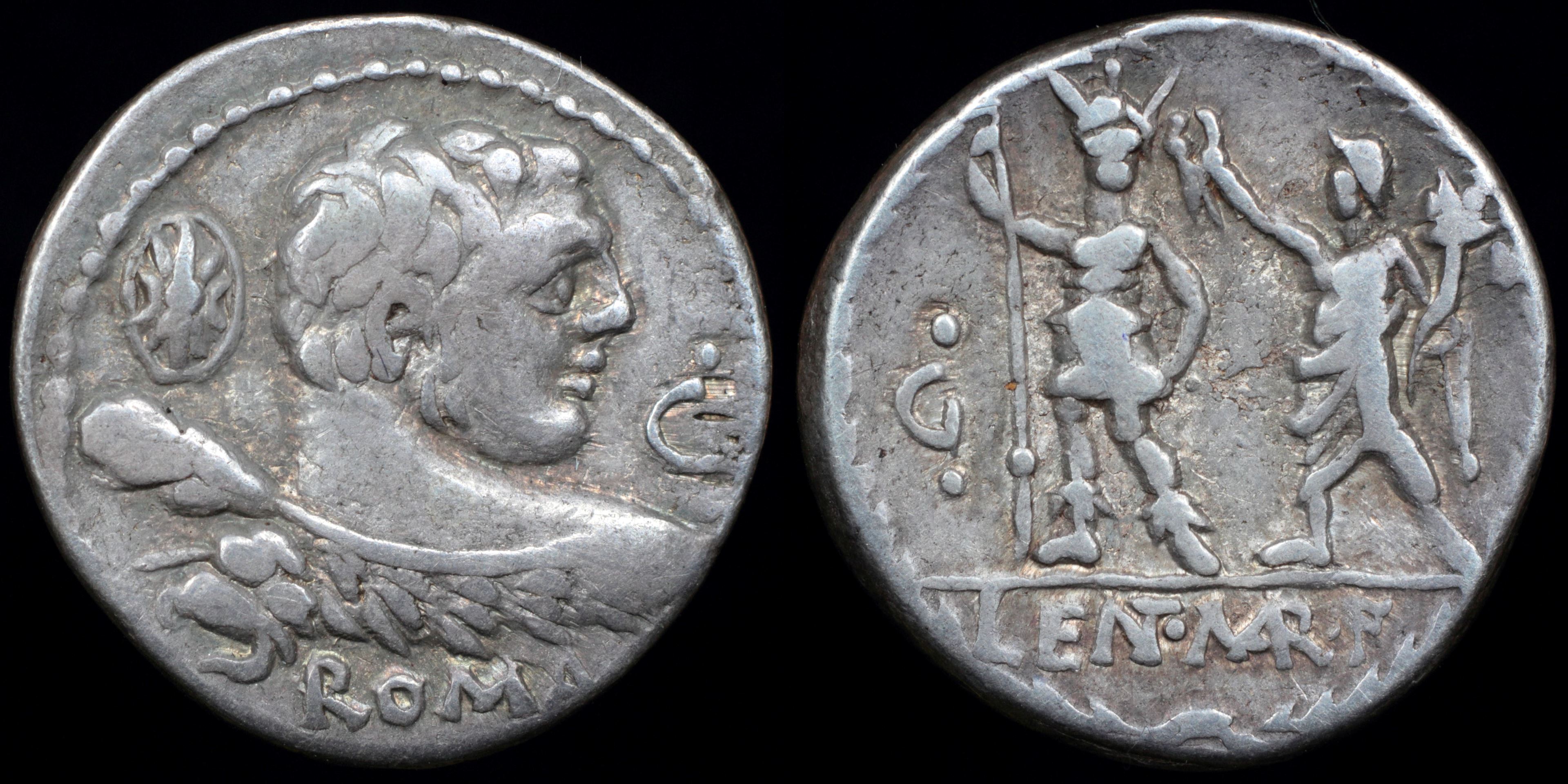
Reverse: Roma facing wearing helmet, holding spear is crowned by Genius standing left, holding wreath and cornucopia, all within laurel wreath, dot above and below G, LE(NT)·(MAR)·F
Die Orientation: -
Weight: 4 g
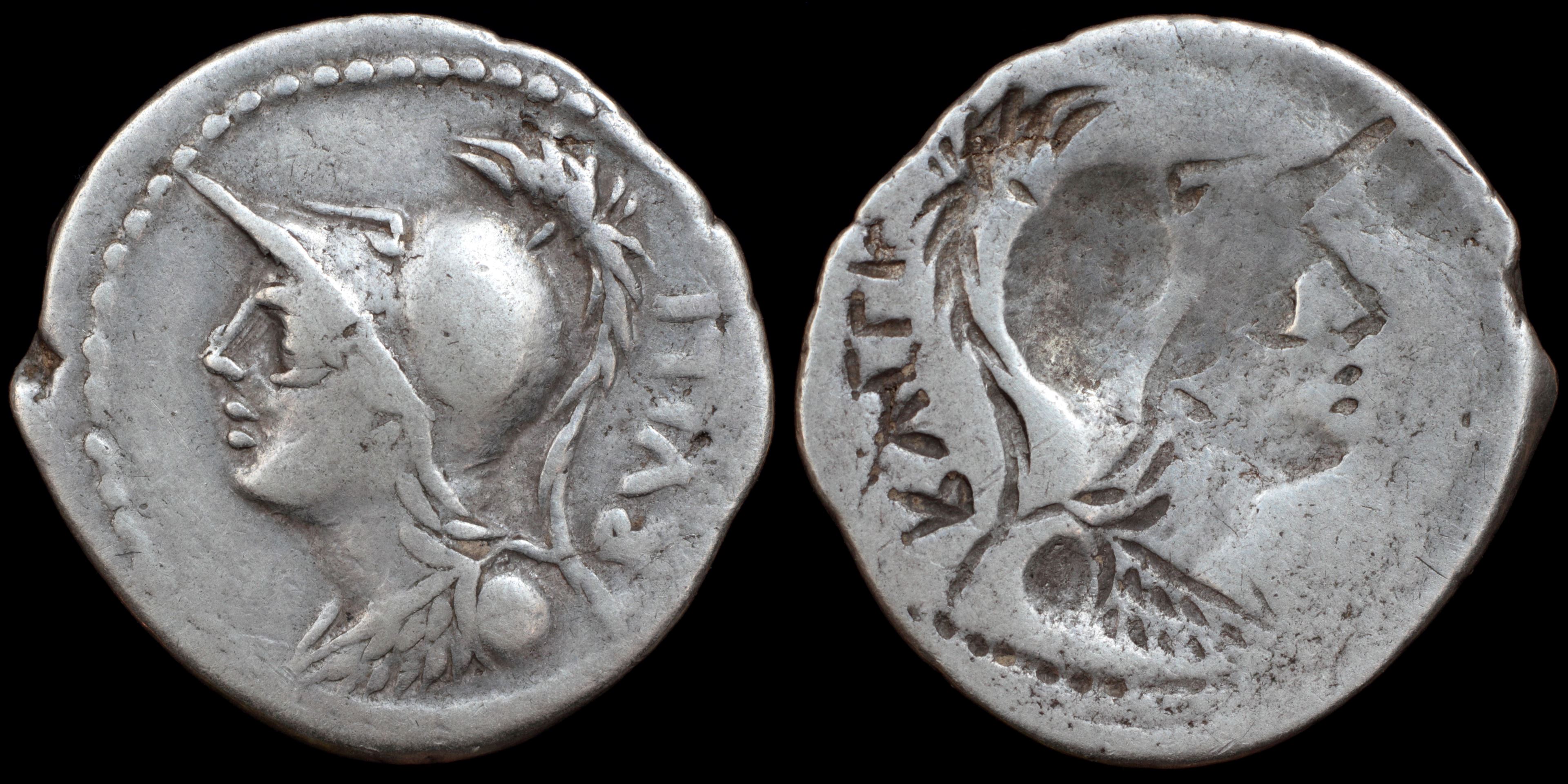
Reverse: Brockage - incuse obverse
Die Orientation: -
Weight: 3.76 g
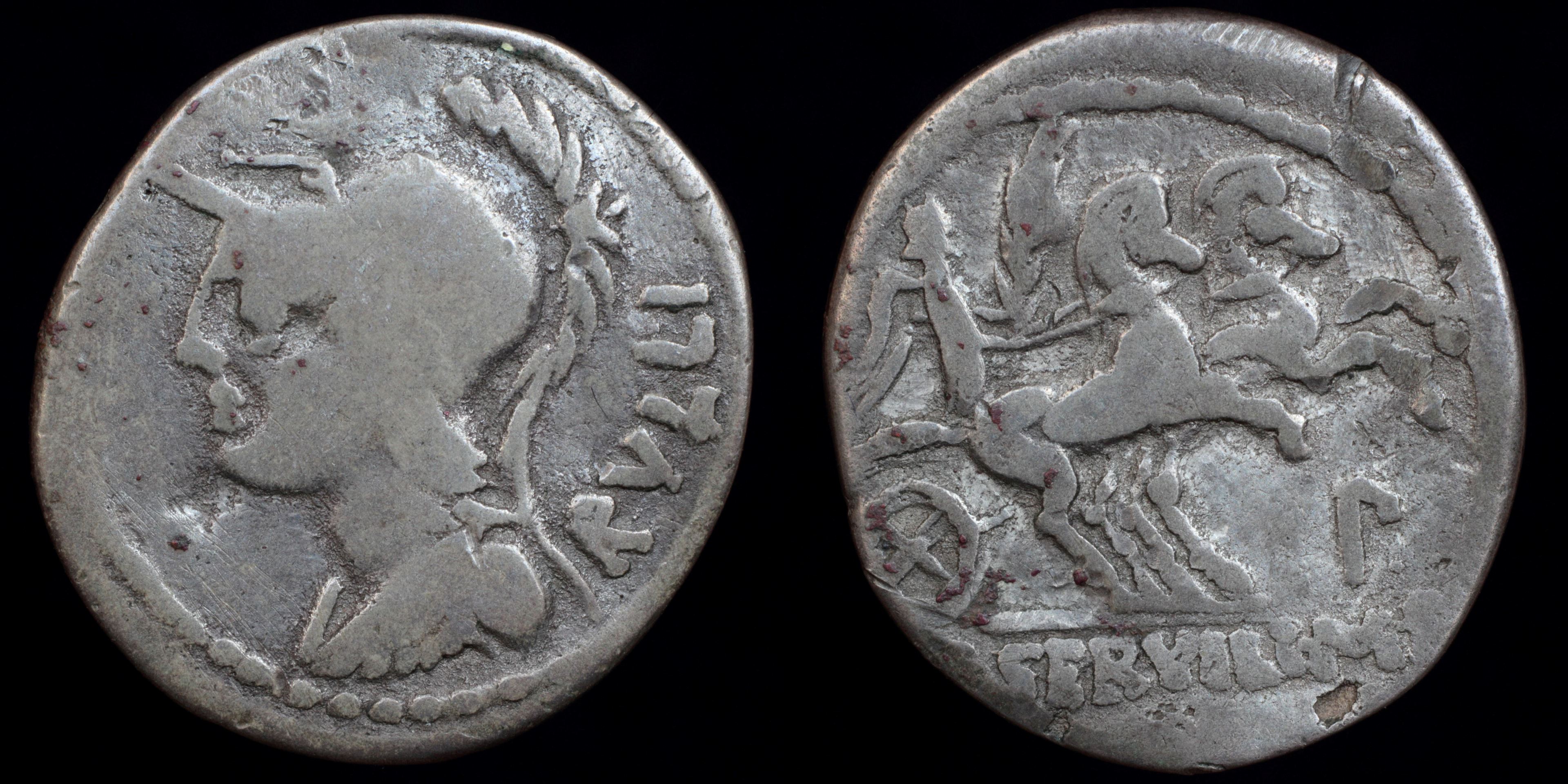
Reverse: Victory in biga right, holding palm branch P. SERVILI.M.F
Die Orientation: -
Weight: 3.3 g
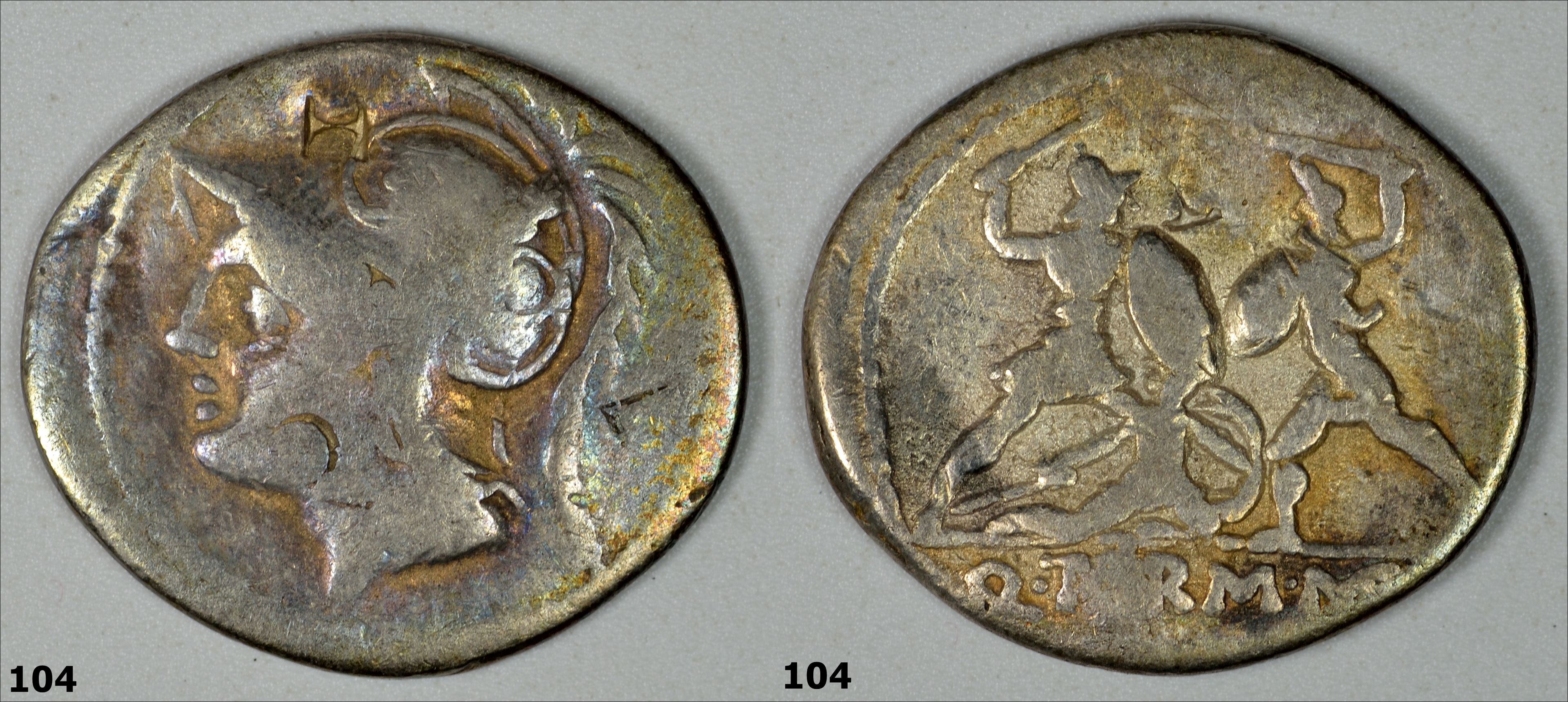
Reverse: Q*TERM*MF below two warriors in combat, one on left protecting a fallen man
Die Orientation: -
Weight: 3.5 g

Reverse: Two warriors fighting, each armed with sword in right hand and shield in left; the one on the left protects a fallen comrade; the other wears horned helmet; Q•THERM•MF in exergue.
Die Orientation: -
Weight: 4.02 g
He may also have been the same Thermus who served as military tribune under Scipio in North Africa in 202 BC. Appian relates that about this time there was a cavalry engagement between the forces of Hannibal and those of Scipio near Zama, in which the latter had the advantage. On the succeeding days they had sundry skirmishes until Scipio, learning that Hannibal was very short of supplies and was expecting a convoy, sent the military tribune, [Quintus Minucius] Thermus, by night to attack the supply train. Thermus took a position on the crest of a hill at a narrow pass, where he killed 4,000 Africans, took as many more prisoners, and brought the supplies to Scipio."
Provenance: e-Bay sale (May 2018).
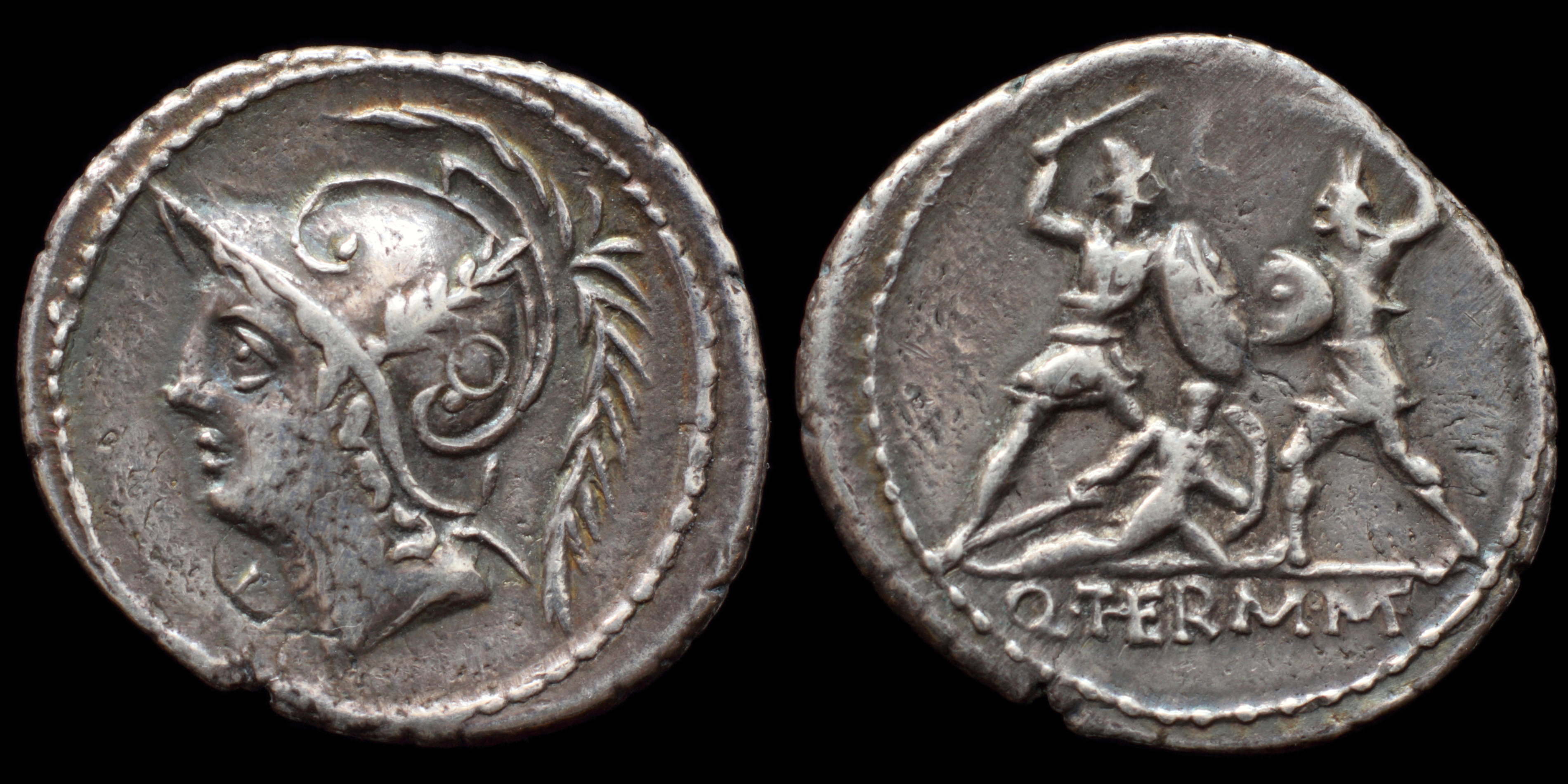
Reverse: Q. Minucius Q.f. L.n. Thermus right fighting barbarian (Ligurian) left wearing horned helmet over Roman soldier kneeling right; everyone holding sword and shield; Q·(THE)RM·(MF)
Die Orientation: -
Weight: 3.9 g
(11).JPG)
Reverse: Two warriors in combat, one on left protecting a fallen man; Q•TERM•MF in exergue
Die Orientation: 6 H
Weight: 3.94 g
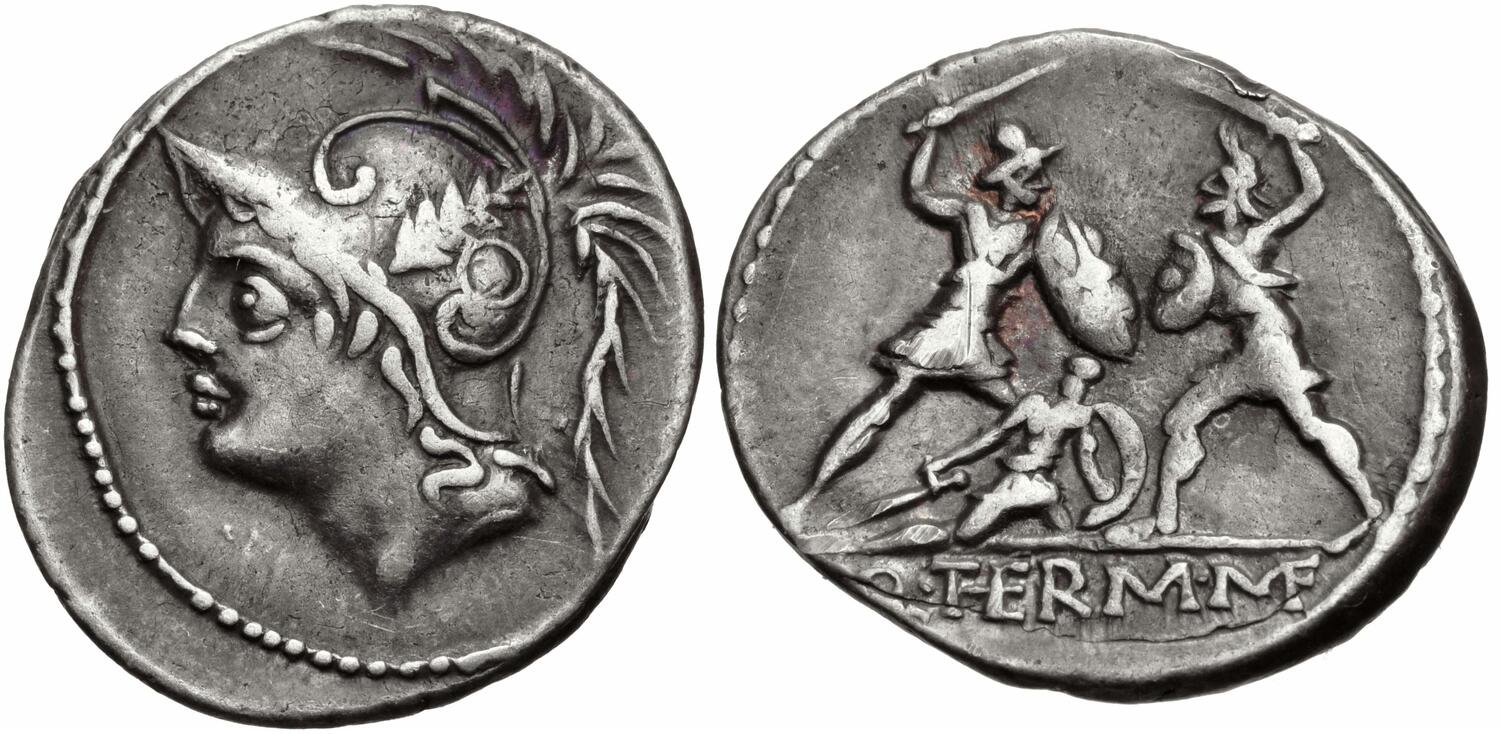
Reverse: Two warriors fighting, each armed with sword and shield; the one on the left protects a fallen comrade, the other wears horned helmet
Die Orientation: 7 H
Weight: 3.88 g
Toned, a few scratches, scrape on reverse. VF. From the Raintree Collection.
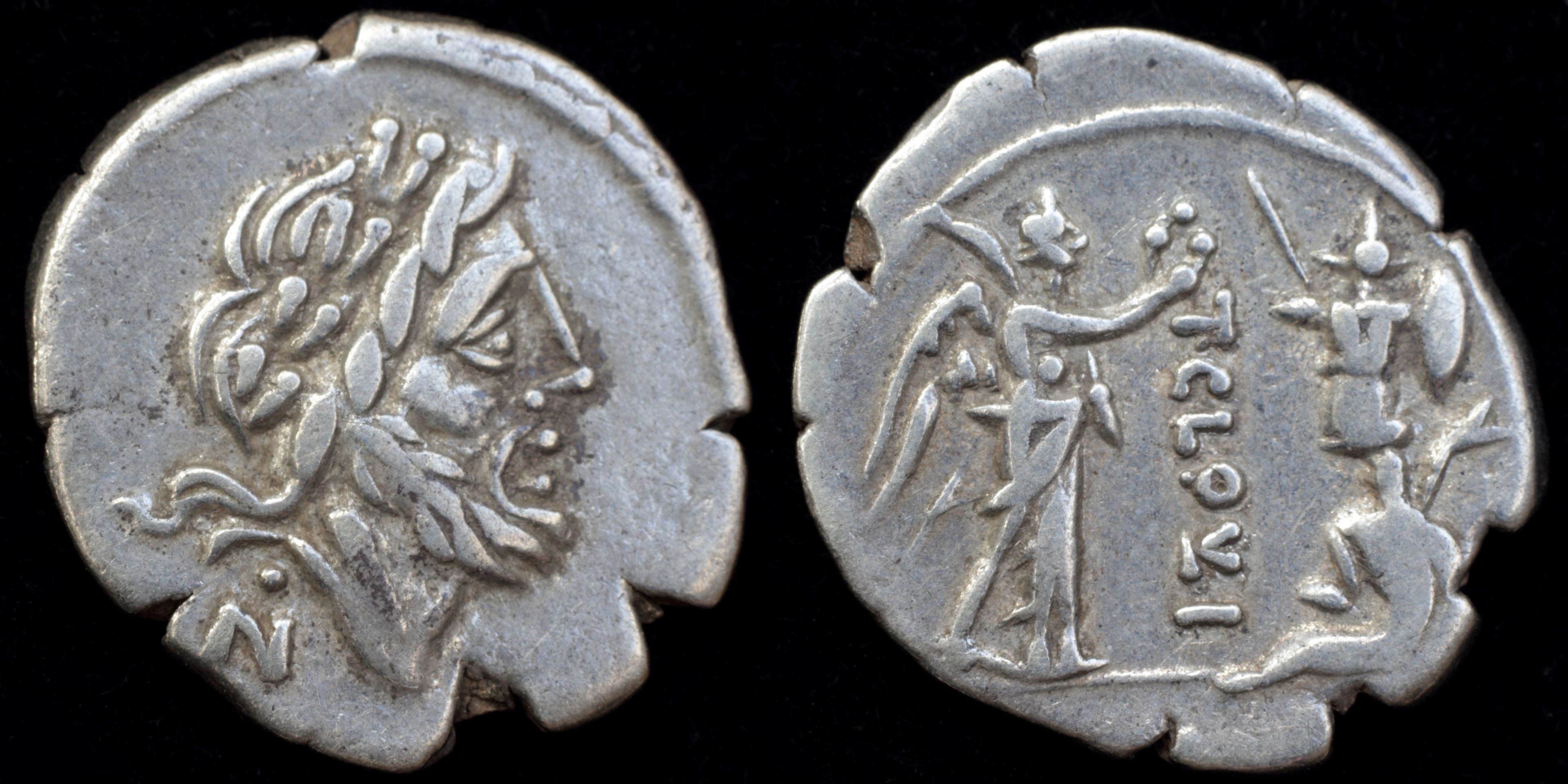
Reverse: Victory standing right, holding wreath and palm. Trophy with Gallic captive seated left, T·CLO(VL)I, Q
Die Orientation: -
Weight: 1.9 g
T. Cloulius, supporter of Gaius Marius, struck this issue as questor. This coin commemorates Marius' victory over Teutones in the battle of Aquae Sextiae 102 BC and over Cimbri one year later.
